使用者:Icosohedral/沙盒1
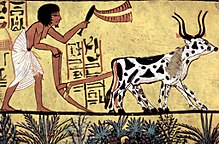 |
| 農業和農學 |
|---|
| 農業史 |
| 農業 |
| 其他類型 |
| 有關 |
| 分類 |
|
|
農業(英語:Agriculture)包括作物種植、畜牧、漁業養殖、林業等活動,旨在生產食物或非食物原料。[1]農業是人類文明轉向定居形式的里程碑,藉助對馴化物種的培育與繁殖,人們獲得了充足的食物與資源,並導致最初城市的發展成型。人類在10.5萬年前開始從野外採集穀物,但直到1.15萬年前才開始種植,並大約在1萬年前馴化了綿羊、山羊、豬、牛等家畜。世界上至少有11個地區獨立發展出了作物種植。自20世紀開始,基於單一作物種植的工業化農業開始占據世界農業產出的主要來源。
如今,小型農場的食物產出約占世界總量的三分之一,但大型農場正變得十分普遍。占據前1%大小的農場平均面積超過50公頃,所管理的土地面積占所有耕地面積70%。將近40%的耕地屬於面積超過1,000公頃的巨型農場。不過,六分之五的農場面積仍小於2公頃。[2]
農業的主要產物是食物、纖維、能源和原材料(例如橡膠)。其中食物包括穀物、蔬菜、水果、食用油、肉類、奶製品、蛋和菌類。全球農業產出約110億噸食物[3],3200萬噸自然纖維[4]和40億m3木材。[5]不過,其中有14%的食物在到達零售環節之前被浪費。[6]
現代農業技術、植物育種、農業化學產品(例如殺蟲劑和化肥)的發展顯著增加了作物產量,但也帶來了諸多生態與環境問題。選擇育種和現代畜牧業技術發展促進了肉類製品產量,但同時造成了動物福利和環境問題。這些環境問題包括氣候變化、地下含水層枯竭、森林砍伐、抗生素耐藥性和農業污染。農業既是環境退化的起因,也深受其影響。生物多樣性喪失、荒漠化、土壤退化、氣候變化等因素都會降低作物產量。轉基因作物被廣泛使用,但也有部分國家禁止此類作物種植。
Etymology and scope
[編輯]The word agriculture is a late Middle English adaptation of Latin agricultūra, from ager 'field' and cultūra 'cultivation' or 'growing'.[7] While agriculture usually refers to human activities, certain species of ant,[8][9] termite and beetle have been cultivating crops for up to 60 million years.[10] Agriculture is defined with varying scopes, in its broadest sense using natural resources to "produce commodities which maintain life, including food, fiber, forest products, horticultural crops, and their related services".[11] Thus defined, it includes arable farming, horticulture, animal husbandry and forestry, but horticulture and forestry are in practice often excluded.[11] It may also be broadly decomposed into plant agriculture, which concerns the cultivation of useful plants,[12] and animal agriculture, the production of agricultural animals.[13]
廣義而言,農業是指利用自然資源生產維持生命所需的物品,包括食物、纖維、林業產品、園藝作物,以及與之相關的服務。[11]因此,廣義的農業包括種植業、園藝、動物養殖(畜牧業、水產養殖等)和林業,但有時園藝和林業也被排除在外。[11]此外,農業可因管理對象不同而分為兩類:植物農業,主要涉及作物的培育;動物農業,主要關注農業動物產品。[13]
History
[編輯]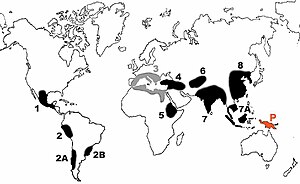
起源
[編輯]The development of agriculture enabled the human population to grow many times larger than could be sustained by hunting and gathering.[16] Agriculture began independently in different parts of the globe,[17] and included a diverse range of taxa, in at least 11 separate centers of origin.[14] Wild grains were collected and eaten from at least 105,000 years ago.[18] In the Paleolithic Levant, 23,000 years ago, cereals cultivation of emmer, barley, and oats has been observed near the sea of Galilee.[19][20] Rice was domesticated in China between 11,500 and 6,200 BC with the earliest known cultivation from 5,700 BC,[21] followed by mung, soy and azuki beans. Sheep were domesticated in Mesopotamia between 13,000 and 11,000 years ago.[22] Cattle were domesticated from the wild aurochs in the areas of modern Turkey and Pakistan some 10,500 years ago.[23] Pig production emerged in Eurasia, including Europe, East Asia and Southwest Asia,[24] where wild boar were first domesticated about 10,500 years ago.[25] In the Andes of South America, the potato was domesticated between 10,000 and 7,000 years ago, along with beans, coca, llamas, alpacas, and guinea pigs. Sugarcane and some root vegetables were domesticated in New Guinea around 9,000 years ago. Sorghum was domesticated in the Sahel region of Africa by 7,000 years ago. Cotton was domesticated in Peru by 5,600 years ago,[26] and was independently domesticated in Eurasia. In Mesoamerica, wild teosinte was bred into maize by 6,000 years ago.[27] The horse was domesticated in the Eurasian Steppes around 3500 BC.[28] Scholars have offered multiple hypotheses to explain the historical origins of agriculture. Studies of the transition from hunter-gatherer to agricultural societies indicate an initial period of intensification and increasing sedentism; examples are the Natufian culture in the Levant, and the Early Chinese Neolithic in China. Then, wild stands that had previously been harvested started to be planted, and gradually came to be domesticated.[29][30][31]
得益於農業發展,世界人口數量相比狩獵採集時代有了顯著增長。[16]農業獨立起源於多個地區[17],根據分類單元歸為至少11個起源中心。[14]早在10.5萬年前,人們就已開始採集並食用野生穀物。[18]在2.3萬年前新石器時代的黎凡特,人們開始在加利利海附近種植二粒小麥、大麥和燕麥。[19][20]中國先民於13,500-8200年馴化了水稻,已知最早耕種時間距今約7,700年[21],而後綠豆、大豆、紅豆也在此區域馴化。美索不達米亞人於1.3萬-1.1萬年前馴化了綿羊。[22]而家牛則是從1.05萬年前生活在現今土耳其和巴基斯坦地區的原牛馴化而來。[23]家豬的馴化獨立在歐洲、東亞和東南亞進行[24],最早馴化時間距今約1.05萬年。[25]在南美洲安第斯山脈,人們在10,000-7,000年前馴化了馬鈴薯,晚些時候又馴化了豆子、古柯、羊駝、大羊駝和豚鼠。高粱於7,000年前在非洲薩赫勒被馴化。棉花於5,600年前在秘魯被馴化[26],後也在歐亞大陸獨立馴化。玉米源於野生玉蜀黍屬,於6,000年前在中美洲馴化。[27]公元前3,500年左右,馬在歐亞大草原被馴化。[28]關於農業的起源有大量研究,學者為此提出了眾多假說。人類從狩獵採集向農業社會的轉型伴隨著集約化和定居的發展,相關過渡期案例有黎凡特地區的納圖夫文化和中國早期的新石器文化。隨著生活方式的轉變,人們開始在定居點種植以往在野外採集的資源,由此導致這些物種的逐漸馴化。[29][30][31]
古文明時期農業發展
[編輯]
In Eurasia, the Sumerians started to live in villages from about 8,000 BC, relying on the Tigris and Euphrates rivers and a canal system for irrigation. Ploughs appear in pictographs around 3,000 BC; seed-ploughs around 2,300 BC. Farmers grew wheat, barley, vegetables such as lentils and onions, and fruits including dates, grapes, and figs.[33] Ancient Egyptian agriculture relied on the Nile River and its seasonal flooding. Farming started in the predynastic period at the end of the Paleolithic, after 10,000 BC. Staple food crops were grains such as wheat and barley, alongside industrial crops such as flax and papyrus.[34][35] In India, wheat, barley and jujube were domesticated by 9,000 BC, soon followed by sheep and goats.[36] Cattle, sheep and goats were domesticated in Mehrgarh culture by 8,000–6,000 BC.[37][38][39] Cotton was cultivated by the 5th–4th millennium BC.[40] Archeological evidence indicates an animal-drawn plough from 2,500 BC in the Indus Valley civilisation.[41]
公元前8000年,歐亞大陸的蘇美爾人開始以村莊形式定居,並依靠底格里斯河和幼發拉底河灌溉作物。其公元前3000年的象形符號中出現了犁,公元前2300年出現了播種犁。蘇美爾農夫種植大麥、小麥、蔬菜(例如扁豆和洋蔥)、水果(例如椰棗、葡萄和無花果)。[33]古埃及農業始於舊石器時代末期的前王朝時期,時間大約在公元前10,000年,主要依靠尼羅河和當地季節性洪水灌溉作物。當地人種植的主要糧食作物為大麥和小麥,此外還有亞麻和紙莎草等經濟作物。[34][35]印度先民在公元前9,000年前馴化了小麥、大麥和棗,後續又馴化了綿羊和山羊。[36]在公元前8,000-6,000年的梅赫爾格爾文化中,巴基斯坦先民馴化了牛、綿羊和山羊。[37][38][39]棉花在公元前4-5世紀馴化。[40]此外,考古證據顯示,在公元前2,500年的印度河流域文明中,出現了使用動物牽引的犁。[41]
In China, from the 5th century BC there was a nationwide granary system and widespread silk farming.[42] Water-powered grain mills were in use by the 1st century BC,[43] followed by irrigation.[44] By the late 2nd century, heavy ploughs had been developed with iron ploughshares and mouldboards.[45][46] These spread westwards across Eurasia.[47] Asian rice was domesticated 8,200–13,500 years ago – depending on the molecular clock estimate that is used[48]– on the Pearl River in southern China with a single genetic origin from the wild rice Oryza rufipogon.[49] In Greece and Rome, the major cereals were wheat, emmer, and barley, alongside vegetables including peas, beans, and olives. Sheep and goats were kept mainly for dairy products.[50][51]
在中國地區,公元前5世紀開始出現穀倉建築,以及以獲取絲綢為目的的蠶業。[42]公元1世紀開始使用水磨[43]和水利灌溉[44],公元2世紀晚期開始出現帶有金屬犁鏵和犁板的重型犁[45][46],隨後這些技術向西在歐亞大陸傳播。[47]藉助基因分子鐘估算,亞洲水稻的馴化時間大約在8,200-13,500年前[48],馴化地點位於中國西南部的珠江流域,原始物種為野生稻(Oryza rufipogon)。[49]古希臘和古羅馬種植的主要穀物為小麥、二粒小麥和大麥,蔬菜包括豌豆、大豆和橄欖,綿羊和山羊養殖主要是為獲取奶製品。[50][51]
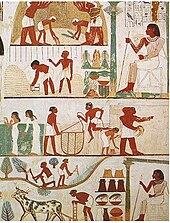
In the Americas, crops domesticated in Mesoamerica (apart from teosinte) include squash, beans, and cacao.[52] Cocoa was being domesticated by the Mayo Chinchipe of the upper Amazon around 3,000 BC.[53] The turkey was probably domesticated in Mexico or the American Southwest.[54] The Aztecs developed irrigation systems, formed terraced hillsides, fertilized their soil, and developed chinampas or artificial islands. The Mayas used extensive canal and raised field systems to farm swampland from 400 BC.[55][56][57][58][59] Coca was domesticated in the Andes, as were the peanut, tomato, tobacco, and pineapple.[52] Cotton was domesticated in Peru by 3,600 BC.[60] Animals including llamas, alpacas, and guinea pigs were domesticated there.[61] In North America, the indigenous people of the East domesticated crops such as sunflower, tobacco,[62] squash and Chenopodium.[63][64] Wild foods including wild rice and maple sugar were harvested.[65] The domesticated strawberry is a hybrid of a Chilean and a North American species, developed by breeding in Europe and North America.[66] The indigenous people of the Southwest and the Pacific Northwest practiced forest gardening and fire-stick farming. The natives controlled fire on a regional scale to create a low-intensity fire ecology that sustained a low-density agriculture in loose rotation; a sort of "wild" permaculture.[67][68][69][70] A system of companion planting called the Three Sisters was developed in North America. The three crops were winter squash, maize, and climbing beans.[71][72]
中美洲馴化的穀物有南瓜、大豆、可可[52],其中可可是由居住在亞馬孫河上游的馬由-欽奇佩文化先民馴化,時間大約在公元前3,000年。[53]火雞可能在墨西哥或美洲西南部馴化。[54]中美洲阿茲特克人發展了灌溉系統,在山坡上耕作梯田,為土壤施肥,建造人工浮田和人工島。生活在美洲中部的瑪雅人從公元前400年開始建造大量人工河道,以在沼澤地帶開拓農田。[55][56][57][58][59]古柯由南美洲安第斯山脈先民馴化,在同一地區馴化的作物還有花生、番茄、菸草和菠蘿。[52]棉花在公元前3,600年的秘魯馴化[60],同在此地馴化的動物還包括羊駝、大羊駝、豚鼠。[61]北美東部原住民馴化了向日葵、菸草[62]、南瓜和藜屬作物[63][64],人們也從野外採集野生稻米和楓糖。[65]人工馴化的草莓源自智利和北美野生物種的雜交,後由歐洲與北美人進一步馴化。[66]北美西南部和太平洋西北地區原住民種植樹林,並有計劃的引燃林火。原住民會控制樹林火勢,將其限制在特定區域,藉此創造有利於農業持續發展的林火生態。[67][68][69][70]北美原住民還發展了一種名為「三姐妹」的同伴種植系統,這三種作物為冬南瓜、玉米和荷包豆。[71][72]
Indigenous Australians, long supposed to have been nomadic hunter-gatherers, practised systematic burning, possibly to enhance natural productivity in fire-stick farming.[73] Scholars have pointed out that hunter-gatherers need a productive environment to support gathering without cultivation. Because the forests of New Guinea have few food plants, early humans may have used "selective burning" to increase the productivity of the wild karuka fruit trees to support the hunter-gatherer way of life.[74]
普遍認為澳大利亞原住民是游牧的狩獵採集者,他們會有計劃地在野外放火,可能是為了增加火棍農耕中野生作物的產量。[73]學者指出,狩獵採集者需要讓周圍環境中野生作物產量維持在特定水平,只有這樣才可在不耕作的情況下滿足生存需求。新幾內亞森林中可食用植物較為稀少,因此當地先民可能會實行「選擇性放火」,以提高野生高大貝葉棕的果實產量。[74]
The Gunditjmara and other groups developed eel farming and fish trapping systems from some 5,000 years ago.[75] There is evidence of 'intensification' across the whole continent over that period.[76] In two regions of Australia, the central west coast and eastern central, early farmers cultivated yams, native millet, and bush onions, possibly in permanent settlements.[31][77]
澳大利亞貢迪吉馬拉人自5,000年開始飼養鰻魚。[75]澳洲中西部海岸和中東部海岸先民曾種植山藥、本地小米、野洋蔥(bush onion),種植地點或許是位於其永久定居點。[31][77]
晚近時期農業發展
[編輯]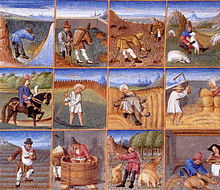
In the Middle Ages, compared to the Roman period, agriculture in Western Europe became more focused on self-sufficiency. The agricultural population under feudalism was typically organized into manors consisting of several hundred or more acres of land presided over by a Lord with a Roman Catholic church and priest.[78]
Thanks to the exchange with the Al-Andalus where the Arab Agricultural Revolution was underway, European agriculture transformed with improved techniques and the diffusion of crop plants, including the introduction of sugar, rice, cotton and fruit trees (such as the orange).[79]
相比羅馬時期,中世紀歐洲人更注重農業的自給自足。農業人口在封建制度下組織成大型莊園,這些莊園通常有上百英畝土地,土地所有者一般是羅馬天主教會及其牧師。[78]得益於阿拉伯農業革命成果傳播,歐洲農業取得了許多新的技術,並引入了新的栽培物種,稻米、棉花和果樹。[79]
After 1492 the Columbian exchange brought New World crops such as maize, potatoes, tomatoes, sweet potatoes and manioc to Europe, and Old World crops such as wheat, barley, rice and turnips, and livestock (including horses, cattle, sheep and goats) to the Americas.[80]
15世紀哥倫布發現美洲後,舊大陸與新大陸之間交換了大量農業產品,美洲大陸的玉米、馬鈴薯、番茄、番薯、木薯等作物傳入歐洲,而舊世界的小麥、大麥、稻米、蕪菁等作物,以及馬、牛、綿羊、山羊等牲畜傳入新大陸。[80]
Irrigation, crop rotation, and fertilizers advanced from the 17th century with the British Agricultural Revolution, allowing global population to rise significantly. Since 1900 agriculture in developed nations, and to a lesser extent in the developing world, has seen large rises in productivity as mechanization replaces human labor, and assisted by synthetic fertilizers, pesticides, and selective breeding. The Haber-Bosch method allowed the synthesis of ammonium nitrate fertilizer on an industrial scale, greatly increasing crop yields and sustaining a further increase in global population.[81][82] Modern agriculture has raised or encountered ecological, political, and economic issues including water pollution, biofuels, genetically modified organisms, tariffs and farm subsidies, leading to alternative approaches such as the organic movement.[83][84] In the 1930, there was a Dust Bowl in the United States with tragic consequences.[85]
自17世紀英國農業革命後,灌溉、輪作、化肥技術的發展促使世界人口快速增長。而自20世紀以來,已開發國家逐漸以機械自動化設備取代農業中的人工勞作,並利用合成肥料、殺蟲劑和選擇育種協助農業工作。德國化學家弗里茨·哈伯提出的哈伯法可大量生產硝酸銨,其作為一種重要的肥料,極大提高了農業產量,促進20世紀人口的迅速增長。[81][82]不過,現代農業也引發了許多生態環境、政治、經濟相關議題,例如水污染、生物燃料、轉基因作物、關稅、農業補貼等,這些問題促使人們開始關注有機農業。[83][84]
Types
[編輯]

Pastoralism involves managing domesticated animals. In nomadic pastoralism, herds of livestock are moved from place to place in search of pasture, fodder, and water. This type of farming is practised in arid and semi-arid regions of Sahara, Central Asia and some parts of India.[86]

In shifting cultivation, a small area of forest is cleared by cutting and burning the trees. The cleared land is used for growing crops for a few years until the soil becomes too infertile, and the area is abandoned. Another patch of land is selected and the process is repeated. This type of farming is practiced mainly in areas with abundant rainfall where the forest regenerates quickly. This practice is used in Northeast India, Southeast Asia, and the Amazon Basin.[87]
Subsistence farming is practiced to satisfy family or local needs alone, with little left over for transport elsewhere. It is intensively practiced in Monsoon Asia and South-East Asia.[88] An estimated 2.5 billion subsistence farmers worked in 2018, cultivating about 60% of the earth's arable land.[89]
Intensive farming is cultivation to maximise productivity, with a low fallow ratio and a high use of inputs (water, fertilizer, pesticide and automation). It is practiced mainly in developed countries.[90][91]
Contemporary agriculture
[編輯]Status
[編輯]From the twentieth century onwards, intensive agriculture increased crop productivity. It substituted synthetic fertilizers and pesticides for labour, but caused increased water pollution, and often involved farm subsidies. Soil degradation and diseases such as stem rust are major concerns globally;[92] approximately 40% of the world's agricultural land is seriously degraded.[93][94] In recent years there has been a backlash against the environmental effects of conventional agriculture, resulting in the organic, regenerative, and sustainable agriculture movements.[83][95] One of the major forces behind this movement has been the European Union, which first certified organic food in 1991 and began reform of its Common Agricultural Policy (CAP) in 2005 to phase out commodity-linked farm subsidies,[96] also known as decoupling. The growth of organic farming has renewed research in alternative technologies such as integrated pest management, selective breeding,[97] and controlled-environment agriculture.[98][99] There are concerns about the lower yield associated with organic farming and its impact on global food security.[100] Recent mainstream technological developments include genetically modified food.[101]
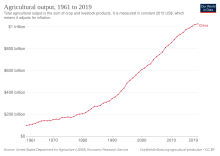
By 2015, the agricultural output of China was the largest in the world, followed by the European Union, India and the United States.[102] Economists measure the total factor productivity of agriculture, according to which agriculture in the United States is roughly 1.7 times more productive than it was in 1948.[103]
Despite increases in agricultural production and productivity,[104] between 702 and 828 million people were affected by hunger in 2021.[105] Food insecurity and malnutrition can be the result of conflict, climate extremes and variability and economic swings.[104] It can also be caused by a country’s structural characteristics such as income status and natural resource endowments as well as its political economy.[104]
The International Fund for Agricultural Development posits that an increase in smallholder agriculture may be part of the solution to concerns about food prices and overall food security, given the favorable experience of Vietnam.[106]
Workforce
[編輯]Agriculture provides about one-quarter of all global employment, more than half in sub-Saharan Africa and almost 60 percent in low-income countries.[107] As countries develop, other jobs have historically pulled workers away from agriculture, and labour-saving innovations increase agricultural productivity by reducing labour requirements per unit of output.[108][109][110] Over time, a combination of labour supply and labour demand trends have driven down the share of population employed in agriculture.[111]

During the 16th century in Europe, between 55 and 75% of the population was engaged in agriculture; by the 19th century, this had dropped to between 35 and 65%.[112] In the same countries today, the figure is less than 10%.[113] At the start of the 21st century, some one billion people, or over 1/3 of the available work force, were employed in agriculture. This constitutes approximately 70% of the global employment of children, and in many countries constitutes the largest percentage of women of any industry.[114] The service sector overtook the agricultural sector as the largest global employer in 2007.[115]
In many developed countries, immigrants help fill labour shortages in high-value agriculture activities that are difficult to mechanize.[116] Foreign farm workers from mostly Eastern Europe, North Africa and South Asia constituted around one-third of the salaried agricultural workforce in Spain, Italy, Greece and Portugal in 2013.[117][118][119][120] In the United States of America, more than half of all hired farmworkers (roughly 450,000 workers) were immigrants in 2019, although the number of new immigrants arriving in the country to work in agriculture has fallen by 75 percent in recent years and rising wages indicate this has led to a major labor shortage on U.S. farms.[121][122]
Around the world, women make up a large share of the population employed in agriculture.[123] This share is growing in all developing regions except East and Southeast Asia where women already make up about 50 percent of the agricultural workforce.[123] Women make up 47 percent of the agricultural workforce in sub-Saharan Africa, a rate that has not changed significantly in the past few decades.[123] However, the Food and Agriculture Organization of the United Nations (FAO) posits that the roles and responsibilities of women in agriculture may be changing – for example, from subsistence farming to wage employment, and from contributing household members to primary producers in the context of male-out-migration.[123]
Safety
[編輯]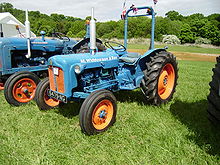
Agriculture, specifically farming, remains a hazardous industry, and farmers worldwide remain at high risk of work-related injuries, lung disease, noise-induced hearing loss, skin diseases, as well as certain cancers related to chemical use and prolonged sun exposure. On industrialized farms, injuries frequently involve the use of agricultural machinery, and a common cause of fatal agricultural injuries in developed countries is tractor rollovers.[124] Pesticides and other chemicals used in farming can be hazardous to worker health, and workers exposed to pesticides may experience illness or have children with birth defects.[125] As an industry in which families commonly share in work and live on the farm itself, entire families can be at risk for injuries, illness, and death.[126] Ages 0–6 May be an especially vulnerable population in agriculture;[127] common causes of fatal injuries among young farm workers include drowning, machinery and motor accidents, including with all-terrain vehicles.[126][127][128]
The International Labour Organization considers agriculture "one of the most hazardous of all economic sectors".[114] It estimates that the annual work-related death toll among agricultural employees is at least 170,000, twice the average rate of other jobs. In addition, incidences of death, injury and illness related to agricultural activities often go unreported.[129] The organization has developed the Safety and Health in Agriculture Convention, 2001, which covers the range of risks in the agriculture occupation, the prevention of these risks and the role that individuals and organizations engaged in agriculture should play.[114]
In the United States, agriculture has been identified by the National Institute for Occupational Safety and Health as a priority industry sector in the National Occupational Research Agenda to identify and provide intervention strategies for occupational health and safety issues.[130][131] In the European Union, the European Agency for Safety and Health at Work has issued guidelines on implementing health and safety directives in agriculture, livestock farming, horticulture, and forestry.[132] The Agricultural Safety and Health Council of America (ASHCA) also holds a yearly summit to discuss safety.[133]
Production
[編輯]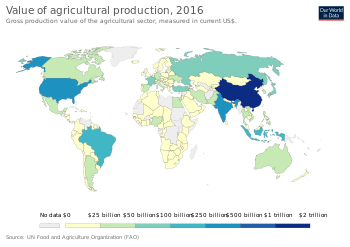
Overall production varies by country as listed.
| Largest countries by agricultural output (in nominal terms) according to IMF and CIA World Factbook, at peak level as of 2018 | ||||||||||||||||||||||||||||||||||||||||||||||||||||||
|---|---|---|---|---|---|---|---|---|---|---|---|---|---|---|---|---|---|---|---|---|---|---|---|---|---|---|---|---|---|---|---|---|---|---|---|---|---|---|---|---|---|---|---|---|---|---|---|---|---|---|---|---|---|---|
| ||||||||||||||||||||||||||||||||||||||||||||||||||||||
| Largest countries by agricultural output according to UNCTAD at 2005 constant prices and exchange rates, 2015[102] | ||||||||||||
|---|---|---|---|---|---|---|---|---|---|---|---|---|
| ||||||||||||
Crop cultivation systems
[編輯]
Cropping systems vary among farms depending on the available resources and constraints; geography and climate of the farm; government policy; economic, social and political pressures; and the philosophy and culture of the farmer.[135][136]
Shifting cultivation (or slash and burn) is a system in which forests are burnt, releasing nutrients to support cultivation of annual and then perennial crops for a period of several years.[137] Then the plot is left fallow to regrow forest, and the farmer moves to a new plot, returning after many more years (10–20). This fallow period is shortened if population density grows, requiring the input of nutrients (fertilizer or manure) and some manual pest control. Annual cultivation is the next phase of intensity in which there is no fallow period. This requires even greater nutrient and pest control inputs.[137]
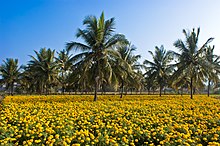
Further industrialization led to the use of monocultures, when one cultivar is planted on a large acreage. Because of the low biodiversity, nutrient use is uniform and pests tend to build up, necessitating the greater use of pesticides and fertilizers.[136] Multiple cropping, in which several crops are grown sequentially in one year, and intercropping, when several crops are grown at the same time, are other kinds of annual cropping systems known as polycultures.[137]
In subtropical and arid environments, the timing and extent of agriculture may be limited by rainfall, either not allowing multiple annual crops in a year, or requiring irrigation. In all of these environments perennial crops are grown (coffee, chocolate) and systems are practiced such as agroforestry. In temperate environments, where ecosystems were predominantly grassland or prairie, highly productive annual farming is the dominant agricultural system.[137]
Important categories of food crops include cereals, legumes, forage, fruits and vegetables.[138] Natural fibers include cotton, wool, hemp, silk and flax.[139] Specific crops are cultivated in distinct growing regions throughout the world. Production is listed in millions of metric tons, based on FAO estimates.[138]
| Top agricultural products, by crop types (million tonnes) 2004 data | |
|---|---|
| Cereals | 2,263 |
| Vegetables and melons | 866 |
| Roots and tubers | 715 |
| Milk | 619 |
| Fruit | 503 |
| Meat | 259 |
| Oilcrops | 133 |
| Fish (2001 estimate) | 130 |
| Eggs | 63 |
| Pulses | 60 |
| Vegetable fiber | 30 |
| Source: Food and Agriculture Organization[138] | |
| Top agricultural products, by individual crops (million tonnes) 2011 data | |
|---|---|
| Sugar cane | 1794 |
| Maize | 883 |
| Rice | 722 |
| Wheat | 704 |
| Potatoes | 374 |
| Sugar beet | 271 |
| Soybeans | 260 |
| Cassava | 252 |
| Tomatoes | 159 |
| Barley | 134 |
| Source: Food and Agriculture Organization[138] | |
Livestock production systems
[編輯]
Animal husbandry is the breeding and raising of animals for meat, milk, eggs, or wool, and for work and transport.[140] Working animals, including horses, mules, oxen, water buffalo, camels, llamas, alpacas, donkeys, and dogs, have for centuries been used to help cultivate fields, harvest crops, wrangle other animals, and transport farm products to buyers.[141]
Livestock production systems can be defined based on feed source, as grassland-based, mixed, and landless.[142] 截至2010年[update], 30% of Earth's ice- and water-free area was used for producing livestock, with the sector employing approximately 1.3 billion people. Between the 1960s and the 2000s, there was a significant increase in livestock production, both by numbers and by carcass weight, especially among beef, pigs and chickens, the latter of which had production increased by almost a factor of 10. Non-meat animals, such as milk cows and egg-producing chickens, also showed significant production increases. Global cattle, sheep and goat populations are expected to continue to increase sharply through 2050.[143] Aquaculture or fish farming, the production of fish for human consumption in confined operations, is one of the fastest growing sectors of food production, growing at an average of 9% a year between 1975 and 2007.[144]
During the second half of the 20th century, producers using selective breeding focused on creating livestock breeds and crossbreeds that increased production, while mostly disregarding the need to preserve genetic diversity. This trend has led to a significant decrease in genetic diversity and resources among livestock breeds, leading to a corresponding decrease in disease resistance and local adaptations previously found among traditional breeds.[145]

Grassland based livestock production relies upon plant material such as shrubland, rangeland, and pastures for feeding ruminant animals. Outside nutrient inputs may be used, however manure is returned directly to the grassland as a major nutrient source. This system is particularly important in areas where crop production is not feasible because of climate or soil, representing 30–40 million pastoralists.[137] Mixed production systems use grassland, fodder crops and grain feed crops as feed for ruminant and monogastric (one stomach; mainly chickens and pigs) livestock. Manure is typically recycled in mixed systems as a fertilizer for crops.[142]
Landless systems rely upon feed from outside the farm, representing the de-linking of crop and livestock production found more prevalently in Organisation for Economic Co-operation and Development member countries. Synthetic fertilizers are more heavily relied upon for crop production and manure use becomes a challenge as well as a source for pollution.[142] Industrialized countries use these operations to produce much of the global supplies of poultry and pork. Scientists estimate that 75% of the growth in livestock production between 2003 and 2030 will be in confined animal feeding operations, sometimes called factory farming. Much of this growth is happening in developing countries in Asia, with much smaller amounts of growth in Africa.[143] Some of the practices used in commercial livestock production, including the usage of growth hormones, are controversial.[146]
Production practices
[編輯]
Tillage is the practice of breaking up the soil with tools such as the plow or harrow to prepare for planting, for nutrient incorporation, or for pest control. Tillage varies in intensity from conventional to no-till. It can improve productivity by warming the soil, incorporating fertilizer and controlling weeds, but also renders soil more prone to erosion, triggers the decomposition of organic matter releasing CO2, and reduces the abundance and diversity of soil organisms.[147][148]
Pest control includes the management of weeds, insects, mites, and diseases. Chemical (pesticides), biological (biocontrol), mechanical (tillage), and cultural practices are used. Cultural practices include crop rotation, culling, cover crops, intercropping, composting, avoidance, and resistance. Integrated pest management attempts to use all of these methods to keep pest populations below the number which would cause economic loss, and recommends pesticides as a last resort.[149]
Nutrient management includes both the source of nutrient inputs for crop and livestock production, and the method of use of manure produced by livestock. Nutrient inputs can be chemical inorganic fertilizers, manure, green manure, compost and minerals.[150] Crop nutrient use may also be managed using cultural techniques such as crop rotation or a fallow period. Manure is used either by holding livestock where the feed crop is growing, such as in managed intensive rotational grazing, or by spreading either dry or liquid formulations of manure on cropland or pastures.[147][151]

Water management is needed where rainfall is insufficient or variable, which occurs to some degree in most regions of the world.[137] Some farmers use irrigation to supplement rainfall. In other areas such as the Great Plains in the U.S. and Canada, farmers use a fallow year to conserve soil moisture for the following year.[152] Recent technological innovations in precision agriculture allow for water status monitoring and automate water usage, leading to more efficient management.[153] Agriculture represents 70% of freshwater use worldwide.[154] However, water withdrawal ratios for agriculture vary significantly by income level. In least developed countries and landlocked developing countries, water withdrawal ratios for agriculture are as high as 90 percent of total water withdrawals and about 60 percent in Small Island Developing States.[155]
According to 2014 report by the International Food Policy Research Institute, agricultural technologies will have the greatest impact on food production if adopted in combination with each other. Using a model that assessed how eleven technologies could impact agricultural productivity, food security and trade by 2050, the International Food Policy Research Institute found that the number of people at risk from hunger could be reduced by as much as 40% and food prices could be reduced by almost half.[156]
Payment for ecosystem services is a method of providing additional incentives to encourage farmers to conserve some aspects of the environment. Measures might include paying for reforestation upstream of a city, to improve the supply of fresh water.[157]
Agricultural automation
[編輯]Different definitions exist for agricultural automation and for the variety of tools and technologies that are used to automate production. One view is that agricultural automation refers to autonomous navigation by robots without human intervention.[158] Alternatively it is defined as the accomplishment of production tasks through mobile, autonomous, decision-making, mechatronic devices.[159] However, FAO finds that these definitions do not capture all the aspects and forms of automation, such as robotic milking machines that are static, most motorized machinery that automates the performing of agricultural operations, and digital tools (e.g. sensors) that automate only diagnosis.[153] FAO defines agricultural automation as the use of machinery and equipment in agricultural operations to improve their diagnosis, decision-making or performing, reducing the drudgery of agricultural work and/or improving the timeliness, and potentially the precision, of agricultural operations.[160]
The technological evolution in agriculture has involved a progressive move from manual tools to animal traction, to motorized mechanization, to digital equipment and finally, to robotics with artificial intelligence (AI).[160] Motorized mechanization using engine power automates the performance of agricultural operations such as ploughing and milking.[161] With digital automation technologies, it also becomes possible to automate diagnosis and decision-making of agricultural operations.[160] For example, autonomous crop robots can harvest and seed crops, while drones can gather information to help automate input application.[153] Precision agriculture often employs such automation technologies.[153] Motorized machines are increasingly complemented, or even superseded, by new digital equipment that automates diagnosis and decision-making.[161] A conventional tractor, for example, can be converted into an automated vehicle allowing it to sow a field autonomously.[161]
Motorized mechanization has increased significantly across the world in recent years, although reliable global data with broad country coverage exist only for tractors and only up to 2009.[162] Sub-Saharan Africa is the only region where the adoption of motorized mechanization has stalled over the past decades.[153][163]
Automation technologies are increasingly used for managing livestock, though evidence on adoption is lacking. Global automatic milking system sales have increased over recent years,[164] but adoption is likely mostly in Northern Europe,[165] and likely almost absent in low- and middle-income countries. Automated feeding machines for both cows and poultry also exist, but data and evidence regarding their adoption trends and drivers is likewise scarce.[166][153]
Measuring the overall employment impacts of agricultural automation is difficult because it requires large amounts of data tracking all the transformations and the associated reallocation of workers both upstream and downstream.[160] While automation technologies reduce labour needs for the newly automated tasks, they also generate new labour demand for other tasks, such as equipment maintenance and operation.[153] Agricultural automation can also stimulate employment by allowing producers to expand production and by creating other agrifood systems jobs.[167] This is especially true when it happens in context of rising scarcity of rural labour, as is the case in high-income countries and many middle-income countries.[167] On the other hand, if forcedly promoted, for example through government subsidies in contexts of abundant rural labour, it can lead to labour displacement and falling or stagnant wages, particularly affecting poor and low-skilled workers.[167]
Effects of climate change on yields
[編輯]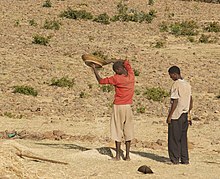
Climate change and agriculture are interrelated on a global scale. Global warming affects agriculture through changes in average temperatures, rainfall, and weather extremes (like storms and heat waves); changes in pests and diseases; changes in atmospheric carbon dioxide and ground-level ozone concentrations; changes in the nutritional quality of some foods;[168] and changes in sea level.[169] Global warming is already affecting agriculture, with effects unevenly distributed across the world.[170] Future climate change will probably negatively affect crop production in low latitude countries, while effects in northern latitudes may be positive or negative.[170] Global warming will probably increase the risk of food insecurity for some vulnerable groups, such as the poor.[171]
Crop alteration and biotechnology
[編輯]Plant breeding
[編輯]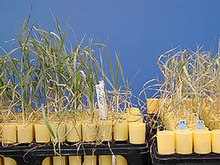
Crop alteration has been practiced by humankind for thousands of years, since the beginning of civilization. Altering crops through breeding practices changes the genetic make-up of a plant to develop crops with more beneficial characteristics for humans, for example, larger fruits or seeds, drought-tolerance, or resistance to pests. Significant advances in plant breeding ensued after the work of geneticist Gregor Mendel. His work on dominant and recessive alleles, although initially largely ignored for almost 50 years, gave plant breeders a better understanding of genetics and breeding techniques. Crop breeding includes techniques such as plant selection with desirable traits, self-pollination and cross-pollination, and molecular techniques that genetically modify the organism.[172]
Domestication of plants has, over the centuries increased yield, improved disease resistance and drought tolerance, eased harvest and improved the taste and nutritional value of crop plants. Careful selection and breeding have had enormous effects on the characteristics of crop plants. Plant selection and breeding in the 1920s and 1930s improved pasture (grasses and clover) in New Zealand. Extensive X-ray and ultraviolet induced mutagenesis efforts (i.e. primitive genetic engineering) during the 1950s produced the modern commercial varieties of grains such as wheat, corn (maize) and barley.[173][174]

The Green Revolution popularized the use of conventional hybridization to sharply increase yield by creating "high-yielding varieties". For example, average yields of corn (maize) in the US have increased from around 2.5 tons per hectare (t/ha) (40 bushels per acre) in 1900 to about 9.4 t/ha (150 bushels per acre) in 2001. Similarly, worldwide average wheat yields have increased from less than 1 t/ha in 1900 to more than 2.5 t/ha in 1990. South American average wheat yields are around 2 t/ha, African under 1 t/ha, and Egypt and Arabia up to 3.5 to 4 t/ha with irrigation. In contrast, the average wheat yield in countries such as France is over 8 t/ha. Variations in yields are due mainly to variation in climate, genetics, and the level of intensive farming techniques (use of fertilizers, chemical pest control, growth control to avoid lodging).[175][176][177]
Genetic engineering
[編輯]
Genetically modified organisms (GMO) are organisms whose genetic material has been altered by genetic engineering techniques generally known as recombinant DNA technology. Genetic engineering has expanded the genes available to breeders to use in creating desired germlines for new crops. Increased durability, nutritional content, insect and virus resistance and herbicide tolerance are a few of the attributes bred into crops through genetic engineering.[178] For some, GMO crops cause food safety and food labeling concerns. Numerous countries have placed restrictions on the production, import or use of GMO foods and crops.[179] Currently a global treaty, the Biosafety Protocol, regulates the trade of GMOs. There is ongoing discussion regarding the labeling of foods made from GMOs, and while the EU currently requires all GMO foods to be labeled, the US does not.[180]
Herbicide-resistant seed has a gene implanted into its genome that allows the plants to tolerate exposure to herbicides, including glyphosate. These seeds allow the farmer to grow a crop that can be sprayed with herbicides to control weeds without harming the resistant crop. Herbicide-tolerant crops are used by farmers worldwide.[181] With the increasing use of herbicide-tolerant crops, comes an increase in the use of glyphosate-based herbicide sprays. In some areas glyphosate resistant weeds have developed, causing farmers to switch to other herbicides.[182][183] Some studies also link widespread glyphosate usage to iron deficiencies in some crops, which is both a crop production and a nutritional quality concern, with potential economic and health implications.[184]
Other GMO crops used by growers include insect-resistant crops, which have a gene from the soil bacterium Bacillus thuringiensis (Bt), which produces a toxin specific to insects. These crops resist damage by insects.[185] Some believe that similar or better pest-resistance traits can be acquired through traditional breeding practices, and resistance to various pests can be gained through hybridization or cross-pollination with wild species. In some cases, wild species are the primary source of resistance traits; some tomato cultivars that have gained resistance to at least 19 diseases did so through crossing with wild populations of tomatoes.[186]
Environmental impact
[編輯]Effects and costs
[編輯]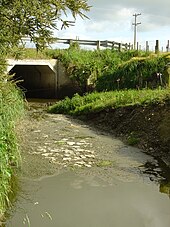
Agriculture is both a cause of and sensitive to environmental degradation, such as biodiversity loss, desertification, soil degradation and global warming, which cause decrease in crop yield.[187] Agriculture is one of the most important drivers of environmental pressures, particularly habitat change, climate change, water use and toxic emissions. Agriculture is the main source of toxins released into the environment, including insecticides, especially those used on cotton.[188][189][頁碼請求] The 2011 UNEP Green Economy report stated that agricultural operations produced some 13 per cent of anthropogenic global greenhouse gas emissions. This includes gases from the use of inorganic fertilizers, agro-chemical pesticides, and herbicides, as well as fossil fuel-energy inputs.[190]
Agriculture imposes multiple external costs upon society through effects such as pesticide damage to nature (especially herbicides and insecticides), nutrient runoff, excessive water usage, and loss of natural environment. A 2000 assessment of agriculture in the UK determined total external costs for 1996 of £2,343 million, or £208 per hectare.[191] A 2005 analysis of these costs in the US concluded that cropland imposes approximately $5 to $16 billion ($30 to $96 per hectare), while livestock production imposes $714 million.[192] Both studies, which focused solely on the fiscal impacts, concluded that more should be done to internalize external costs. Neither included subsidies in their analysis, but they noted that subsidies also influence the cost of agriculture to society.[191][192]
Agriculture seeks to increase yield and to reduce costs. Yield increases with inputs such as fertilisers and removal of pathogens, predators, and competitors (such as weeds). Costs decrease with increasing scale of farm units, such as making fields larger; this means removing hedges, ditches and other areas of habitat. Pesticides kill insects, plants and fungi. These and other measures have cut biodiversity to very low levels on intensively farmed land.[193] Effective yields fall with on-farm losses, which may be caused by poor production practices during harvesting, handling, and storage.[194]
The environmental effects of climate change show that research on pests and diseases that do not generally afflict areas is essential. In 2021, farmers discovered stem rust on wheat in the Champagne area of France, a disease that had previously only occurred in Morocco for 20 to 30 years. Because of climate change, insects that used to die off over the winter are now alive and multiplying.[195][196]
Livestock issues
[編輯]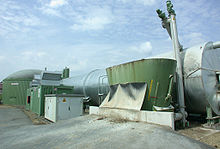
A senior UN official, Henning Steinfeld, said that "Livestock are one of the most significant contributors to today's most serious environmental problems".[197] Livestock production occupies 70% of all land used for agriculture, or 30% of the land surface of the planet. It is one of the largest sources of greenhouse gases, responsible for 18% of the world's greenhouse gas emissions as measured in CO2 equivalents. By comparison, all transportation emits 13.5% of the CO2. It produces 65% of human-related nitrous oxide (which has 296 times the global warming potential of CO2) and 37% of all human-induced methane (which is 23 times as warming as CO2.) It also generates 64% of the ammonia emission. Livestock expansion is cited as a key factor driving deforestation; in the Amazon basin 70% of previously forested area is now occupied by pastures and the remainder used for feed crops.[198] Through deforestation and land degradation, livestock is also driving reductions in biodiversity. Furthermore, the UNEP states that "methane emissions from global livestock are projected to increase by 60 per cent by 2030 under current practices and consumption patterns."[190]
Land and water issues
[編輯]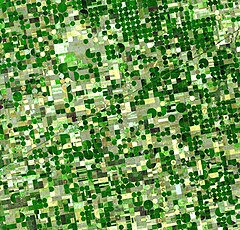
Land transformation, the use of land to yield goods and services, is the most substantial way humans alter the Earth's ecosystems, and is the driving force causing biodiversity loss. Estimates of the amount of land transformed by humans vary from 39 to 50%.[199] Land degradation, the long-term decline in ecosystem function and productivity, is estimated to be occurring on 24% of land worldwide, with cropland overrepresented.[200] Land management is the driving factor behind degradation; 1.5 billion people rely upon the degrading land. Degradation can be through deforestation, desertification, soil erosion, mineral depletion, acidification, or salinization.[137]
Eutrophication, excessive nutrient enrichment in aquatic ecosystems resulting in algal blooms and anoxia, leads to fish kills, loss of biodiversity, and renders water unfit for drinking and other industrial uses. Excessive fertilization and manure application to cropland, as well as high livestock stocking densities cause nutrient (mainly nitrogen and phosphorus) runoff and leaching from agricultural land. These nutrients are major nonpoint pollutants contributing to eutrophication of aquatic ecosystems and pollution of groundwater, with harmful effects on human populations.[201] Fertilisers also reduce terrestrial biodiversity by increasing competition for light, favouring those species that are able to benefit from the added nutrients.[202] Agriculture accounts for 70 percent of withdrawals of freshwater resources.[203][204] Agriculture is a major draw on water from aquifers, and currently draws from those underground water sources at an unsustainable rate. It is long known that aquifers in areas as diverse as northern China, the Upper Ganges and the western US are being depleted, and new research extends these problems to aquifers in Iran, Mexico and Saudi Arabia.[205] Increasing pressure is being placed on water resources by industry and urban areas, meaning that water scarcity is increasing and agriculture is facing the challenge of producing more food for the world's growing population with reduced water resources.[206] Agricultural water usage can also cause major environmental problems, including the destruction of natural wetlands, the spread of water-borne diseases, and land degradation through salinization and waterlogging, when irrigation is performed incorrectly.[207]
Pesticides
[編輯]
Pesticide use has increased since 1950 to 2.5 million short tons annually worldwide, yet crop loss from pests has remained relatively constant.[208] The World Health Organization estimated in 1992 that three million pesticide poisonings occur annually, causing 220,000 deaths.[209] Pesticides select for pesticide resistance in the pest population, leading to a condition termed the "pesticide treadmill" in which pest resistance warrants the development of a new pesticide.[210]
An alternative argument is that the way to "save the environment" and prevent famine is by using pesticides and intensive high yield farming, a view exemplified by a quote heading the Center for Global Food Issues website: 'Growing more per acre leaves more land for nature'.[211][212] However, critics argue that a trade-off between the environment and a need for food is not inevitable,[213] and that pesticides can replace good agronomic practices such as crop rotation.[210] The Push–pull agricultural pest management technique involves intercropping, using plant aromas to repel pests from crops (push) and to lure them to a place from which they can then be removed (pull).[214]
Contribution to climate change
[編輯]Agriculture contributes towards climate change through greenhouse gas emissions and by the conversion of non-agricultural land such as forests into agricultural land.[215] The agriculture, forestry and land use sector contribute between 13% and 21% of global greenhouse gas emissions.[216] Emissions of nitrous oxide, methane make up over half of total greenhouse gas emission from agriculture.[217] Animal husbandry is a major source of greenhouse gas emissions.[218]
Sustainability
[編輯]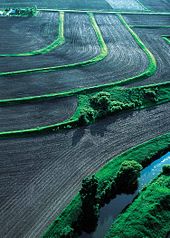
Current farming methods have resulted in over-stretched water resources, high levels of erosion and reduced soil fertility. There is not enough water to continue farming using current practices; therefore how critical water, land, and ecosystem resources are used to boost crop yields must be reconsidered. A solution would be to give value to ecosystems, recognizing environmental and livelihood tradeoffs, and balancing the rights of a variety of users and interests.[219] Inequities that result when such measures are adopted would need to be addressed, such as the reallocation of water from poor to rich, the clearing of land to make way for more productive farmland, or the preservation of a wetland system that limits fishing rights.[220]
Technological advancements help provide farmers with tools and resources to make farming more sustainable.[221] Technology permits innovations like conservation tillage, a farming process which helps prevent land loss to erosion, reduces water pollution, and enhances carbon sequestration.[222] Other potential practices include conservation agriculture, agroforestry, improved grazing, avoided grassland conversion, and biochar.[223][224] Current mono-crop farming practices in the United States preclude widespread adoption of sustainable practices, such as 2-3 crop rotations that incorporate grass or hay with annual crops, unless negative emission goals such as soil carbon sequestration become policy.[225]
The International Food Policy Research Institute states that agricultural technologies will have the greatest impact on food production if adopted in combination with each other; using a model that assessed how eleven technologies could impact agricultural productivity, food security and trade by 2050, it found that the number of people at risk from hunger could be reduced by as much as 40% and food prices could be reduced by almost half.[156] The food demand of Earth's projected population, with current climate change predictions, could be satisfied by improvement of agricultural methods, expansion of agricultural areas, and a sustainability-oriented consumer mindset.[226]
Energy dependence
[編輯]
Since the 1940s, agricultural productivity has increased dramatically, due largely to the increased use of energy-intensive mechanization, fertilizers and pesticides. The vast majority of this energy input comes from fossil fuel sources.[227] Between the 1960s and the 1980s, the Green Revolution transformed agriculture around the globe, with world grain production increasing significantly (between 70% and 390% for wheat and 60% to 150% for rice, depending on geographic area)[228] as world population doubled. Heavy reliance on petrochemicals has raised concerns that oil shortages could increase costs and reduce agricultural output.[229]
Industrialized agriculture depends on fossil fuels in two fundamental ways: direct consumption on the farm and manufacture of inputs used on the farm. Direct consumption includes the use of lubricants and fuels to operate farm vehicles and machinery.[229]
Indirect consumption includes the manufacture of fertilizers, pesticides, and farm machinery.[229] In particular, the production of nitrogen fertilizer can account for over half of agricultural energy usage.[230] Together, direct and indirect consumption by US farms accounts for about 2% of the nation's energy use. Direct and indirect energy consumption by U.S. farms peaked in 1979, and has since gradually declined.[229] Food systems encompass not just agriculture but off-farm processing, packaging, transporting, marketing, consumption, and disposal of food and food-related items. Agriculture accounts for less than one-fifth of food system energy use in the US.[231][232]
Plastic pollution
[編輯]Plastic products are used extensively in agriculture, for example to increase crop yield and improve the efficiency of water and agrichemical use. "Agriplastic" products include films to cover greenhouses and tunnels, mulch to cover soil (e.g. to suppress weeds, conserve water, increase soil temperature and aid fertilizer application), shade cloth, pesticide containers, seedling trays, protective mesh and irrigation tubing. The polymers most commonly used in these products are low- density polyethylene (LPDE), linear low-density polyethylene (LLDPE), polypropylene (PP) and polyvinyl chloride (PVC).[233]
The total amount of plastics used in agriculture is difficult to quantify. A 2012 study reported that almost 6.5 million tonnes per year were consumed globally while a later study estimated that global demand in 2015 was between 7.3 million and 9 million tonnes. Widespread use of plastic mulch and lack of systematic collection and management have led to the generation of large amounts of mulch residue. Weathering and degradation eventually cause the mulch to fragment. These fragments and larger pieces of plastic accumulate in soil. Mulch residue has been measured at levels of 50 to 260 kg per hectare in topsoil in areas where the mulch has been used for more than 10 years, which confirms that mulching is a major source of both microplastic and macroplastic contamination of soil.[233]
Agricultural plastics, especially plastic films, are not easy to recycle because of high contamination levels (up to 40- 50% by weight contamination by pesticides, fertilizers, soil and debris, moist vegetation, silage juice water, and UV stabilizers) and collection difficulties . Therefore, they are often buried or abandoned in fields and watercourses or burned. These disposal practices lead to soil degradation and can result in contamination of soils and leakage of microplastics into the marine environment as a result of precipitation run-off and tidal washing. In addition, additives in residual plastic film (such as UV and thermal stabilizers) may have deleterious effects on crop growth, soil structure, nutrient transport and salt levels. There is a risk that plastic mulch will deteriorate soil quality, deplete soil organic matter stocks, increase soil water repellence and emit greenhouse gases. Microplastics released through fragmentation of agricultural plastics can absorb and concentrate contaminants capable of being passed up the trophic chain.[233]
Disciplines
[編輯]Agricultural economics
[編輯]
Agricultural economics is economics as it relates to the "production, distribution and consumption of [agricultural] goods and services".[235] Combining agricultural production with general theories of marketing and business as a discipline of study began in the late 1800s, and grew significantly through the 20th century.[236] Although the study of agricultural economics is relatively recent, major trends in agriculture have significantly affected national and international economies throughout history, ranging from tenant farmers and sharecropping in the post-American Civil War Southern United States[237] to the European feudal system of manorialism.[238] In the United States, and elsewhere, food costs attributed to food processing, distribution, and agricultural marketing, sometimes referred to as the value chain, have risen while the costs attributed to farming have declined. This is related to the greater efficiency of farming, combined with the increased level of value addition (e.g. more highly processed products) provided by the supply chain. Market concentration has increased in the sector as well, and although the total effect of the increased market concentration is likely increased efficiency, the changes redistribute economic surplus from producers (farmers) and consumers, and may have negative implications for rural communities.[239]
National government policies can significantly change the economic marketplace for agricultural products, in the form of taxation, subsidies, tariffs and other measures.[240] Since at least the 1960s, a combination of trade restrictions, exchange rate policies and subsidies have affected farmers in both the developing and the developed world. In the 1980s, non-subsidized farmers in developing countries experienced adverse effects from national policies that created artificially low global prices for farm products. Between the mid-1980s and the early 2000s, several international agreements limited agricultural tariffs, subsidies and other trade restrictions.[241]
However, 截至2009年[update], there was still a significant amount of policy-driven distortion in global agricultural product prices. The three agricultural products with the most trade distortion were sugar, milk and rice, mainly due to taxation. Among the oilseeds, sesame had the most taxation, but overall, feed grains and oilseeds had much lower levels of taxation than livestock products. Since the 1980s, policy-driven distortions have seen a greater decrease among livestock products than crops during the worldwide reforms in agricultural policy.[240] Despite this progress, certain crops, such as cotton, still see subsidies in developed countries artificially deflating global prices, causing hardship in developing countries with non-subsidized farmers.[242] Unprocessed commodities such as corn, soybeans, and cattle are generally graded to indicate quality, affecting the price the producer receives. Commodities are generally reported by production quantities, such as volume, number or weight.[243]
Agricultural science
[編輯]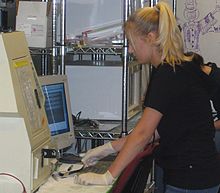
Agricultural science is a broad multidisciplinary field of biology that encompasses the parts of exact, natural, economic and social sciences used in the practice and understanding of agriculture. It covers topics such as agronomy, plant breeding and genetics, plant pathology, crop modelling, soil science, entomology, production techniques and improvement, study of pests and their management, and study of adverse environmental effects such as soil degradation, waste management, and bioremediation.[244][245]
The scientific study of agriculture began in the 18th century, when Johann Friedrich Mayer conducted experiments on the use of gypsum (hydrated calcium sulphate) as a fertilizer.[246] Research became more systematic when in 1843, John Lawes and Henry Gilbert began a set of long-term agronomy field experiments at Rothamsted Research Station in England; some of them, such as the Park Grass Experiment, are still running.[247][248] In America, the Hatch Act of 1887 provided funding for what it was the first to call "agricultural science", driven by farmers' interest in fertilizers.[249] In agricultural entomology, the USDA began to research biological control in 1881; it instituted its first large program in 1905, searching Europe and Japan for natural enemies of the gypsy moth and brown-tail moth, establishing parasitoids (such as solitary wasps) and predators of both pests in the USA.[250][251][252]
Policy
[編輯]| Product | Subsidy |
|---|---|
| Beef and veal | 18.0 |
| Milk | 15.3 |
| Pigs | 7.3 |
| Poultry | 6.5 |
| Soybeans | 2.3 |
| Eggs | 1.5 |
| Sheep | 1.1 |
Agricultural policy is the set of government decisions and actions relating to domestic agriculture and imports of foreign agricultural products. Governments usually implement agricultural policies with the goal of achieving a specific outcome in the domestic agricultural product markets. Some overarching themes include risk management and adjustment (including policies related to climate change, food safety and natural disasters), economic stability (including policies related to taxes), natural resources and environmental sustainability (especially water policy), research and development, and market access for domestic commodities (including relations with global organizations and agreements with other countries).[254] Agricultural policy can also touch on food quality, ensuring that the food supply is of a consistent and known quality, food security, ensuring that the food supply meets the population's needs, and conservation. Policy programs can range from financial programs, such as subsidies, to encouraging producers to enroll in voluntary quality assurance programs.[255]
There are many influences on the creation of agricultural policy, including consumers, agribusiness, trade lobbies and other groups. Agribusiness interests hold a large amount of influence over policy making, in the form of lobbying and campaign contributions. Political action groups, including those interested in environmental issues and labor unions, also provide influence, as do lobbying organizations representing individual agricultural commodities.[256] The Food and Agriculture Organization of the United Nations (FAO) leads international efforts to defeat hunger and provides a forum for the negotiation of global agricultural regulations and agreements. Samuel Jutzi, director of FAO's animal production and health division, states that lobbying by large corporations has stopped reforms that would improve human health and the environment. For example, proposals in 2010 for a voluntary code of conduct for the livestock industry that would have provided incentives for improving standards for health, and environmental regulations, such as the number of animals an area of land can support without long-term damage, were successfully defeated due to large food company pressure.[257]
See also
[編輯]- Aeroponics
- Agricultural aircraft
- Agricultural engineering
- Agricultural machinery
- Agricultural robot
- Agroecology
- Agribusiness
- Agrominerals
- Building-integrated agriculture
- Contract farming
- Corporate farming
- Crofting
- Ecoagriculture
- Hill farming
- List of documentary films about agriculture
- Pharming (genetics)
- Remote sensing
- Soil biodiversity
- Subsistence economy
- Sustainable agriculture
- Vertical farming
- Vegetable farming
References
[編輯]- ^ The State of Food and Agriculture 2021. Making agrifood systems more resilient to shocks and stresses. Rome: Food and Agriculture Organization of the United Nations. 2021. ISBN 978-92-5-134329-6. S2CID 244548456. doi:10.4060/cb4476en.
- ^ Lowder, Sarah K.; Sánchez, Marco V.; Bertini, Raffaele. Which farms feed the world and has farmland become more concentrated?. World Development. 2021-06-01, 142: 105455. ISSN 0305-750X. S2CID 233553897. doi:10.1016/j.worlddev.2021.105455 (英語).
- ^ FAOSTAT. New Food Balance Sheets. FAO. [12 July 2021].
- ^ Discover Natural Fibres Initiative – DNFI.org. dnfi.org. [2023-02-03].
- ^ FAOSTAT. Forestry Production and Trade. FAO. [12 July 2021].
- ^ In Brief: The State of Food and Agriculture 2019. Moving forward on food loss and waste reduction. Rome: Food and Agriculture Organization of the United Nations. 2019.
- ^ Chantrell, Glynnis (編). The Oxford Dictionary of Word Histories
 . Oxford University Press. 2002: 14. ISBN 978-0-19-863121-7.
. Oxford University Press. 2002: 14. ISBN 978-0-19-863121-7.
- ^ St. Fleur, Nicholas. An Ancient Ant-Bacteria Partnership to Protect Fungus. The New York Times. 6 October 2018 [14 July 2020]. (原始內容
 存檔於2022-01-01).
存檔於2022-01-01).
- ^ Li, Hongjie; Sosa Calvo, Jeffrey; Horn, Heidi A.; Pupo, Mônica T.; Clardy, Jon; Rabeling, Cristian; Schultz, Ted R.; Currie, Cameron R. Convergent evolution of complex structures for ant–bacterial defensive symbiosis in fungus-farming ants. Proceedings of the National Academy of Sciences of the United States of America. 2018, 115 (42): 10725. PMC 6196509
 . PMID 30282739. doi:10.1073/pnas.1809332115
. PMID 30282739. doi:10.1073/pnas.1809332115  .
.
- ^ Mueller, Ulrich G.; Gerardo, Nicole M.; Aanen, Duur K.; Six, Diana L.; Schultz, Ted R. The Evolution of Agriculture in Insects. Annual Review of Ecology, Evolution, and Systematics. December 2005, 36: 563–595. doi:10.1146/annurev.ecolsys.36.102003.152626.
- ^ 11.0 11.1 11.2 11.3 Definition of Agriculture. State of Maine. [6 May 2013]. (原始內容存檔於23 March 2012).
- ^ Stevenson, G. C. Plant Agriculture Selected and introduced by Janick Jules and Others San Francisco: Freeman (1970), pp. 246, £2.10. Experimental Agriculture (Cambridge University Press (CUP)). 1971, 7 (4): 363. ISSN 0014-4797. S2CID 85571333. doi:10.1017/s0014479700023371.
- ^ 13.0 13.1 Herren, R.V. Science of Animal Agriculture. Cengage Learning. 2012 [2022-05-01]. ISBN 978-1-133-41722-4. (原始內容存檔於31 May 2022).
- ^ 14.0 14.1 14.2 Larson, G.; Piperno, D. R.; Allaby, R. G.; Purugganan, M. D.; Andersson, L.; Arroyo-Kalin, M.; Barton, L.; Climer Vigueira, C.; Denham, T.; Dobney, K.; Doust, A. N.; Gepts, P.; Gilbert, M. T. P.; Gremillion, K. J.; Lucas, L.; Lukens, L.; Marshall, F. B.; Olsen, K. M.; Pires, J.C.; Richerson, P. J.; Rubio De Casas, R.; Sanjur, O.I.; Thomas, M. G.; Fuller, D.Q. Current perspectives and the future of domestication studies. PNAS. 2014, 111 (17): 6139–6146. Bibcode:2014PNAS..111.6139L. PMC 4035915
 . PMID 24757054. doi:10.1073/pnas.1323964111
. PMID 24757054. doi:10.1073/pnas.1323964111  .
.
- ^ Denham, T. P. Origins of Agriculture at Kuk Swamp in the Highlands of New Guinea. Science. 2003, 301 (5630): 189–193. PMID 12817084. S2CID 10644185. doi:10.1126/science.1085255.
- ^ 16.0 16.1 Bocquet-Appel, Jean-Pierre. When the World's Population Took Off: The Springboard of the Neolithic Demographic Transition. Science. 29 July 2011, 333 (6042): 560–561. Bibcode:2011Sci...333..560B. PMID 21798934. S2CID 29655920. doi:10.1126/science.1208880.
- ^ 17.0 17.1 Stephens, Lucas; Fuller, Dorian; Boivin, Nicole; Rick, Torben; Gauthier, Nicolas; Kay, Andrea; Marwick, Ben; Armstrong, Chelsey Geralda; Barton, C. Michael. Archaeological assessment reveals Earth's early transformation through land use. Science. 30 August 2019, 365 (6456): 897–902. Bibcode:2019Sci...365..897S. ISSN 0036-8075. PMID 31467217. S2CID 201674203. doi:10.1126/science.aax1192. hdl:10150/634688
 .
.
- ^ 18.0 18.1 Harmon, Katherine. Humans feasting on grains for at least 100,000 years. Scientific American. 17 December 2009 [28 August 2016]. (原始內容存檔於17 September 2016).
- ^ 19.0 19.1 Snir, Ainit; Nadel, Dani; Groman-Yaroslavski, Iris; Melamed, Yoel; Sternberg, Marcelo; Bar-Yosef, Ofer; Weiss, Ehud. The Origin of Cultivation and Proto-Weeds, Long Before Neolithic Farming. PLOS ONE. 22 July 2015, 10 (7): e0131422. Bibcode:2015PLoSO..1031422S. ISSN 1932-6203. PMC 4511808
 . PMID 26200895. doi:10.1371/journal.pone.0131422
. PMID 26200895. doi:10.1371/journal.pone.0131422  (英語).
(英語).
- ^ 20.0 20.1 First evidence of farming in Mideast 23,000 years ago: Evidence of earliest small-scale agricultural cultivation. ScienceDaily. [2022-04-23]. (原始內容存檔於23 April 2022) (英語).
- ^ 21.0 21.1 Zong, Y.; When, Z.; Innes, J. B.; Chen, C.; Wang, Z.; Wang, H. Fire and flood management of coastal swamp enabled first rice paddy cultivation in east China. Nature. 2007, 449 (7161): 459–462. Bibcode:2007Natur.449..459Z. PMID 17898767. S2CID 4426729. doi:10.1038/nature06135.
- ^ 22.0 22.1 Ensminger, M. E.; Parker, R. O. Sheep and Goat Science Fifth. Interstate Printers and Publishers. 1986. ISBN 978-0-8134-2464-4.
- ^ 23.0 23.1 McTavish, E. J.; Decker, J. E.; Schnabel, R.D.; Taylor, J. F.; Hillis, D. M. New World cattle show ancestry from multiple independent domestication events. PNAS. 2013, 110 (15): E1398–1406. Bibcode:2013PNAS..110E1398M. PMC 3625352
 . PMID 23530234. doi:10.1073/pnas.1303367110
. PMID 23530234. doi:10.1073/pnas.1303367110  .
.
- ^ 24.0 24.1 Larson, Greger; Dobney, Keith; Albarella, Umberto; Fang, Meiying; Matisoo-Smith, Elizabeth; Robins, Judith; Lowden, Stewart; Finlayson, Heather; Brand, Tina. Worldwide Phylogeography of Wild Boar Reveals Multiple Centers of Pig Domestication. Science. 11 March 2005, 307 (5715): 1618–1621. Bibcode:2005Sci...307.1618L. PMID 15761152. S2CID 39923483. doi:10.1126/science.1106927.
- ^ 25.0 25.1 Larson, Greger; Albarella, Umberto; Dobney, Keith; Rowley-Conwy, Peter; Schibler, Jörg; Tresset, Anne; Vigne, Jean-Denis; Edwards, Ceiridwen J.; Schlumbaum, Angela. Ancient DNA, pig domestication, and the spread of the Neolithic into Europe. PNAS. 25 September 2007, 104 (39): 15276–15281. Bibcode:2007PNAS..10415276L. PMC 1976408
 . PMID 17855556. doi:10.1073/pnas.0703411104
. PMID 17855556. doi:10.1073/pnas.0703411104  .
.
- ^ 26.0 26.1 Broudy, Eric. The Book of Looms: A History of the Handloom from Ancient Times to the Present. UPNE. 1979: 81 [10 February 2019]. ISBN 978-0-87451-649-4. (原始內容存檔於10 February 2018).
- ^ 27.0 27.1 Johannessen, S.; Hastorf, C. A. (eds.) Corn and Culture in the Prehistoric New World, Westview Press, Boulder, Colorado.
- ^ 28.0 28.1 Dance, Amber. The tale of the domesticated horse. Knowable Magazine. 4 May 2022. doi:10.1146/knowable-050422-1
 .
.
- ^ 29.0 29.1 Hillman, G. C. (1996) "Late Pleistocene changes in wild plant-foods available to hunter-gatherers of the northern Fertile Crescent: Possible preludes to cereal cultivation". In D. R. Harris (ed.) The Origins and Spread of Agriculture and Pastoralism in Eurasia, UCL Books, London, pp. 159–203. ISBN 9781857285383
- ^ 30.0 30.1 Sato, Y. (2003) "Origin of rice cultivation in the Yangtze River basin". In Y. Yasuda (ed.) The Origins of Pottery and Agriculture, Roli Books, New Delhi, p. 196
- ^ 31.0 31.1 31.2 31.3 Gerritsen, R. Australia and the Origins of Agriculture. Encyclopedia of Global Archaeology. Archaeopress. 2008: 29–30. ISBN 978-1-4073-0354-3. S2CID 129339276. doi:10.1007/978-1-4419-0465-2_1896.
- ^ Diamond, J.; Bellwood, P. Farmers and Their Languages: The First Expansions. Science. 2003, 300 (5619): 597–603. Bibcode:2003Sci...300..597D. CiteSeerX 10.1.1.1013.4523
 . PMID 12714734. S2CID 13350469. doi:10.1126/science.1078208.
. PMID 12714734. S2CID 13350469. doi:10.1126/science.1078208.
- ^ 33.0 33.1 Farming. British Museum. [15 June 2016]. (原始內容存檔於16 June 2016).
- ^ 34.0 34.1 Janick, Jules. Ancient Egyptian Agriculture and the Origins of Horticulture (PDF). Acta Hort.: 23–39. [1 April 2018]. (原始內容存檔 (PDF)於25 May 2013).
- ^ 35.0 35.1 Kees, Herman. Ancient Egypt: A Cultural Topography
 . University of Chicago Press. 1961. ISBN 9780226429144.
. University of Chicago Press. 1961. ISBN 9780226429144.
- ^ 36.0 36.1 Gupta, Anil K. Origin of agriculture and domestication of plants and animals linked to early Holocene climate amelioration (PDF). Current Science. 2004, 87 (1): 59 [23 April 2019]. JSTOR 24107979. (原始內容存檔 (PDF)於20 January 2019).
- ^ 37.0 37.1 Baber, Zaheer (1996). The Science of Empire: Scientific Knowledge, Civilization, and Colonial Rule in India. State University of New York Press. 19. ISBN 0-7914-2919-9.
- ^ 38.0 38.1 Harris, David R. and Gosden, C. (1996). The Origins and Spread of Agriculture and Pastoralism in Eurasia: Crops, Fields, Flocks And Herds. Routledge. p. 385. ISBN 1-85728-538-7.
- ^ 39.0 39.1 Possehl, Gregory L. (1996). Mehrgarh in Oxford Companion to Archaeology, Ed. Brian Fagan. Oxford University Press.
- ^ 40.0 40.1 Stein, Burton (1998). A History of India. Blackwell Publishing. p. 47. ISBN 0-631-20546-2.
- ^ 41.0 41.1 Lal, R. Thematic evolution of ISTRO: transition in scientific issues and research focus from 1955 to 2000. Soil and Tillage Research. 2001, 61 (1–2): 3–12. doi:10.1016/S0167-1987(01)00184-2.
- ^ 42.0 42.1 Needham, Vol. 6, Part 2, pp. 55–57.
- ^ 43.0 43.1 Needham, Vol. 4, Part 2, pp. 89, 110, 184.
- ^ 44.0 44.1 Needham, Vol. 4, Part 2, p. 110.
- ^ 45.0 45.1 Greenberger, Robert (2006) The Technology of Ancient China, Rosen Publishing Group. pp. 11–12. ISBN 1404205586
- ^ 46.0 46.1 Wang Zhongshu, trans. by K. C. Chang and Collaborators, Han Civilization (New Haven and London: Yale University Press, 1982).
- ^ 47.0 47.1 Glick, Thomas F. Medieval Science, Technology And Medicine: An Encyclopedia. Volume 11 of The Routledge Encyclopedias of the Middle Ages Series. Psychology Press. 2005: 270. ISBN 978-0-415-96930-7.
- ^ 48.0 48.1 Molina, J.; Sikora, M.; Garud, N.; Flowers, J. M.; Rubinstein, S.; Reynolds, A.; Huang, P.; Jackson, S.; Schaal, B. A.; Bustamante, C. D.; Boyko, A. R.; Purugganan, M. D. Molecular evidence for a single evolutionary origin of domesticated rice. Proceedings of the National Academy of Sciences. 2011, 108 (20): 8351–8356. Bibcode:2011PNAS..108.8351M. PMC 3101000
 . PMID 21536870. doi:10.1073/pnas.1104686108
. PMID 21536870. doi:10.1073/pnas.1104686108  .
.
- ^ 49.0 49.1 Huang, Xuehui; Kurata, Nori; Wei, Xinghua; Wang, Zi-Xuan; Wang, Ahong; Zhao, Qiang; Zhao, Yan; Liu, Kunyan; et al. A map of rice genome variation reveals the origin of cultivated rice. Nature. 2012, 490 (7421): 497–501. Bibcode:2012Natur.490..497H. PMC 7518720
 . PMID 23034647. doi:10.1038/nature11532
. PMID 23034647. doi:10.1038/nature11532  .
.
- ^ 50.0 50.1 Koester, Helmut (1995), History, Culture, and Religion of the Hellenistic Age, 2nd edition, Walter de Gruyter, pp. 76–77. ISBN 3-11-014693-2
- ^ 51.0 51.1 White, K. D. (1970), Roman Farming. Cornell University Press.
- ^ 52.0 52.1 52.2 52.3 Murphy, Denis. Plants, Biotechnology and Agriculture. CABI. 2011: 153. ISBN 978-1-84593-913-7.
- ^ 53.0 53.1 Davis, Nicola. Origin of chocolate shifts 1,400 miles and 1,500 years. The Guardian. 29 October 2018 [31 October 2018]. (原始內容存檔於30 October 2018).
- ^ 54.0 54.1 Speller, Camilla F.; et al. Ancient mitochondrial DNA analysis reveals complexity of indigenous North American turkey domestication. PNAS. 2010, 107 (7): 2807–2812. Bibcode:2010PNAS..107.2807S. PMC 2840336
 . PMID 20133614. doi:10.1073/pnas.0909724107
. PMID 20133614. doi:10.1073/pnas.0909724107  .
.
- ^ 55.0 55.1 Mascarelli, Amanda. Mayans converted wetlands to farmland. Nature. 5 November 2010 [17 May 2013]. doi:10.1038/news.2010.587. (原始內容存檔於23 April 2021).
- ^ 56.0 56.1 Morgan, John. Invisible Artifacts: Uncovering Secrets of Ancient Maya Agriculture with Modern Soil Science. Soil Horizons. 6 November 2013, 53 (6): 3. doi:10.2136/sh2012-53-6-lf
 .
.
- ^ 57.0 57.1 Spooner, David M.; McLean, Karen; Ramsay, Gavin; Waugh, Robbie; Bryan, Glenn J. A single domestication for potato based on multilocus amplified fragment length polymorphism genotyping. PNAS. 2005, 102 (41): 14694–14699. Bibcode:2005PNAS..10214694S. PMC 1253605
 . PMID 16203994. doi:10.1073/pnas.0507400102
. PMID 16203994. doi:10.1073/pnas.0507400102  .
.
- ^ 58.0 58.1 Office of International Affairs. Lost Crops of the Incas: Little-Known Plants of the Andes with Promise for Worldwide Cultivation. nap.edu. 1989: 92 [1 April 2018]. ISBN 978-0-309-04264-2. doi:10.17226/1398. (原始內容存檔於2 December 2012).
- ^ 59.0 59.1 Francis, John Michael. Iberia and the Americas. ABC-CLIO. 2005. ISBN 978-1-85109-426-4.
- ^ 60.0 60.1 Broudy, Eric. The Book of Looms: A History of the Handloom from Ancient Times to the Present. UPNE. 1979: 81. ISBN 978-0-87451-649-4.
- ^ 61.0 61.1 Rischkowsky, Barbara; Pilling, Dafydd. The State of the World's Animal Genetic Resources for Food and Agriculture. Food & Agriculture Organization. 2007: 10. ISBN 978-92-5-105762-9.
- ^ 62.0 62.1 Heiser, Carl B. Jr. On possible sources of the tobacco of prehistoric Eastern North America. Current Anthropology. 1992, 33: 54–56. S2CID 144433864. doi:10.1086/204032.
- ^ 63.0 63.1 Ford, Richard I. Prehistoric Food Production in North América. University of Michigan, Museum of Anthropology, Publications Department. 1985: 75 [23 April 2019]. ISBN 978-0-915703-01-2. (原始內容存檔於9 March 2020).
- ^ 64.0 64.1 Adair, Mary J. (1988) Prehistoric Agriculture in the Central Plains. Publications in Anthropology 16. University of Kansas, Lawrence.
- ^ 65.0 65.1 Smith, Andrew. The Oxford Encyclopedia of Food and Drink in America. OUP USA. 2013: 1. ISBN 978-0-19-973496-2.
- ^ 66.0 66.1 Hardigan, Michael A. P0653: Domestication History of Strawberry: Population Bottlenecks and Restructuring of Genetic Diversity through Time. Pland & Animal Genome Conference XXVI 13–17 January 2018 San Diego, California. [28 February 2018]. (原始內容存檔於1 March 2018).
- ^ 67.0 67.1 Sugihara, Neil G.; Van Wagtendonk, Jan W.; Shaffer, Kevin E.; Fites-Kaufman, Joann; Thode, Andrea E. (編). 17. Fire in California's Ecosystems
 . University of California Press. 2006: 417. ISBN 978-0-520-24605-8.
. University of California Press. 2006: 417. ISBN 978-0-520-24605-8.
- ^ 68.0 68.1 Blackburn, Thomas C.; Anderson, Kat (編). Before the Wilderness: Environmental Management by Native Californians. Ballena Press. 1993. ISBN 978-0-87919-126-9.
- ^ 69.0 69.1 Cunningham, Laura. State of Change: Forgotten Landscapes of California. Heyday. 2010: 135, 173–202. ISBN 978-1-59714-136-9.
- ^ 70.0 70.1 Anderson, M. Kat. Tending the Wild: Native American Knowledge And the Management of California's Natural Resources
 . University of California Press. 2006. ISBN 978-0-520-24851-9.
. University of California Press. 2006. ISBN 978-0-520-24851-9.
- ^ 71.0 71.1 Wilson, Gilbert. Agriculture of the Hidatsa Indians: An Indian Interpretation. Dodo Press. 1917: 25 and passim. ISBN 978-1-4099-4233-7. (原始內容存檔於14 March 2016).
- ^ 72.0 72.1 Landon, Amanda J. The "How" of the Three Sisters: The Origins of Agriculture in Mesoamerica and the Human Niche. Nebraska Anthropologist. 2008: 110–124 [1 April 2018]. (原始內容存檔於21 September 2013).
- ^ 73.0 73.1 Jones, R. Fire-stick Farming. Fire Ecology. 2012, 8 (3): 3–8. doi:10.1007/BF03400623
 .
.
- ^ 74.0 74.1 MLA Rowley-Conwy, Peter, and Robert Layton. "Foraging and farming as niche construction: stable and unstable adaptations." Philosophical transactions of the Royal Society of London. Series B, Biological sciences vol. 366,1566 (2011): 849–62. doi:10.1098/rstb.2010.0307
- ^ 75.0 75.1 Williams, Elizabeth. Complex Hunter-Gatherers: A Late Holocene Example from Temperate Australia. Archaeopress Archaeology. 1988, 423.
- ^ Lourandos, Harry. Continent of Hunter-Gatherers: New Perspectives in Australian Prehistory. Cambridge University Press. 1997.
- ^ 77.0 77.1 Gammage, Bill. The Biggest Estate on Earth: How Aborigines made Australia. Allen & Unwin. October 2011: 281–304. ISBN 978-1-74237-748-3.
- ^ 78.0 78.1 National Geographic. Food Journeys of a Lifetime. National Geographic Society. 2015: 126. ISBN 978-1-4262-1609-1.
- ^ 79.0 79.1 Watson, Andrew M. The Arab Agricultural Revolution and Its Diffusion, 700–1100. The Journal of Economic History. 1974, 34 (1): 8–35. S2CID 154359726. doi:10.1017/s0022050700079602.
- ^ 80.0 80.1 Crosby, Alfred. The Columbian Exchange. The Gilder Lehrman Institute of American History. [11 May 2013]. (原始內容存檔於3 July 2013).
- ^ 81.0 81.1 Janick, Jules. Agricultural Scientific Revolution: Mechanical (PDF). Purdue University. [24 May 2013]. (原始內容存檔 (PDF)於25 May 2013). 已忽略未知參數
|df=(幫助) - ^ 82.0 82.1 Reid, John F. The Impact of Mechanization on Agriculture. The Bridge on Agriculture and Information Technology. 2011, 41 (3). (原始內容存檔於5 November 2013).
- ^ 83.0 83.1 83.2 Philpott, Tom. A Brief History of Our Deadly Addiction to Nitrogen Fertilizer. Mother Jones. 19 April 2013 [7 May 2013]. (原始內容存檔於5 May 2013).
- ^ 84.0 84.1 Ten worst famines of the 20th century. Sydney Morning Herald. 15 August 2011. (原始內容存檔於3 July 2014).
- ^ Hobbs, Peter R; Sayre, Ken; Gupta, Raj. The role of conservation agriculture in sustainable agriculture. Philosophical Transactions of the Royal Society B: Biological Sciences. 12 February 2008, 363 (1491): 543–555. PMC 2610169
 . PMID 17720669. doi:10.1098/rstb.2007.2169.
. PMID 17720669. doi:10.1098/rstb.2007.2169.
- ^ Blench, Roger. Pastoralists in the new millennium (PDF). FAO. 2001: 11–12. (原始內容存檔 (PDF)於1 February 2012).
- ^ Shifting cultivation. Survival International. [28 August 2016]. (原始內容存檔於29 August 2016).
- ^ Waters, Tony. The Persistence of Subsistence Agriculture: life beneath the level of the marketplace. Lexington Books. 2007.
- ^ Chinese project offers a brighter farming future. Editorial. Nature. 7 March 2018, 555 (7695): 141. Bibcode:2018Natur.555R.141.. PMID 29517037. doi:10.1038/d41586-018-02742-3
 .
.
- ^ Encyclopædia Britannica's definition of Intensive Agriculture. (原始內容存檔於5 July 2006).
- ^ BBC School fact sheet on intensive farming. (原始內容存檔於3 May 2007).
- ^ Wheat Stem Rust – UG99 (Race TTKSK). FAO. [6 January 2014]. (原始內容存檔於7 January 2014).
- ^ Sample, Ian (31 August 2007). "Global food crisis looms as climate change and population growth strip fertile land" 網際網路檔案館的存檔,存檔日期29 April 2016., The Guardian (London).
- ^ Africa may be able to feed only 25% of its population by 2025. Mongabay. 14 December 2006 [15 July 2016]. (原始內容存檔於27 November 2011).
- ^ Scheierling, Susanne M. Overcoming agricultural pollution of water: the challenge of integrating agricultural and environmental policies in the European Union, Volume 1. The World Bank. 1995 [15 April 2013]. (原始內容存檔於5 June 2013).
- ^ CAP Reform. European Commission. 2003 [15 April 2013]. (原始內容存檔於17 October 2010).
- ^ Poincelot, Raymond P. Organic Farming. Toward a More Sustainable Agriculture. 1986: 14–32. ISBN 978-1-4684-1508-7. doi:10.1007/978-1-4684-1506-3_2.
|journal=被忽略 (幫助) - ^ The cutting-edge technology that will change farming. Agweek. 9 November 2018 [23 November 2018]. (原始內容存檔於17 November 2018).
- ^ Charles, Dan. Hydroponic Veggies Are Taking Over Organic, And A Move To Ban Them Fails. NPR. 3 November 2017 [24 November 2018]. (原始內容存檔於24 November 2018).
- ^ Knapp, Samuel; van der Heijden, Marcel G. A. A global meta-analysis of yield stability in organic and conservation agriculture. Nature Communications. 2018-09-07, 9 (1): 3632. ISSN 2041-1723. PMC 6128901
 . PMID 30194344. doi:10.1038/s41467-018-05956-1 (英語).
. PMID 30194344. doi:10.1038/s41467-018-05956-1 (英語).
- ^ GM Science Review First Report 網際網路檔案館的存檔,存檔日期16 October 2013., Prepared by the UK GM Science Review panel (July 2003). Chairman David King, p. 9
- ^ 102.0 102.1 UNCTADstat – Table view. [26 November 2017]. (原始內容存檔於20 October 2017).
- ^ Agricultural Productivity in the United States. USDA Economic Research Service. 5 July 2012 [22 April 2013]. (原始內容存檔於1 February 2013).
- ^ 104.0 104.1 104.2 The State of Food Security and Nutrition in the World 2022. Repurposing food and agricultural policies to make healthy diets more affordable. Rome: Food and Agriculture Organization of the United Nations. 2022. ISBN 978-92-5-136499-4. doi:10.4060/cc0639en.
- ^ In Brief to The State of Food Security and Nutrition in the World 2022. Repurposing food and agricultural policies to make healthy diets more affordable. Rome: Food and Agriculture Organization of the United Nations. 2022. ISBN 978-92-5-136502-1. doi:10.4060/cc0640en.
- ^ Food prices: smallholder farmers can be part of the solution. International Fund for Agricultural Development. [24 April 2013]. (原始內容存檔於5 May 2013).
- ^ World Bank. 2021. Employment in agriculture (% of total employment) (modeled ILO estimate). The World Bank. Washington, DC. 2021 [12 May 2021].
- ^ Michaels, Guy; Rauch, Ferdinand; Redding, Stephen J. Urbanization and Structural Transformation. The Quarterly Journal of Economics. 2012, 127 (2): 535–586. ISSN 0033-5533. JSTOR 23251993. doi:10.1093/qje/qjs003.
- ^ Gollin, Douglas; Parente, Stephen; Rogerson, Richard. The Role of Agriculture in Development. The American Economic Review. 2002, 92 (2): 160–164. ISSN 0002-8282. JSTOR 3083394. doi:10.1257/000282802320189177.
- ^ Lewis, W. Arthur. Economic Development with Unlimited Supplies of Labour. The Manchester School. 1954, 22 (2): 139–191. ISSN 1463-6786. doi:10.1111/j.1467-9957.1954.tb00021.x (英語).
- ^ FAOSTAT: Employment Indicators: Agriculture. FAO. Rome. 2022 [6 February 2022].
- ^ Allen, Robert C. Economic structure and agricultural productivity in Europe, 1300–1800 (PDF). European Review of Economic History: 1–25. (原始內容 (PDF)存檔於27 October 2014).
- ^ Labor Force – By Occupation. The World Factbook. Central Intelligence Agency. [4 May 2013]. (原始內容存檔於22 May 2014).
- ^ 114.0 114.1 114.2 Safety and health in agriculture. International Labour Organization. 21 March 2011 [1 April 2018]. (原始內容存檔於18 March 2018).
- ^ Services sector overtakes farming as world's biggest employer: ILO. The Financial Express. Associated Press. 26 January 2007 [24 April 2013]. (原始內容存檔於13 October 2013).
- ^ In Brief: The State of Food and Agriculture 2018. Migration, agriculture and rural development. Rome: FAO. 2018.
- ^ Caruso, F. & Corrado, A. Migrazioni e lavoro agricolo: un confronto tra Italia e Spagna in tempi di crisi. M. Colucci & S. Gallo (編). Tempo di cambiare. Rapporto 2015 sulle migrazioni interne in Italia. Rome: Donizelli. 2015: 58–77.
- ^ Kasimis, Charalambos. Migrants in the Rural Economies of Greece and Southern Europe. migrationpolicy.org. 2005-10-01 [2023-02-06] (英語).
- ^ Nori, M. The shades of green: Migrants' contribution to EU agriculture. Context, trends, opportunities, challenges. Florence: Migration Policy Centre. 2017.
- ^ Fonseca, Maria Lucinda. New waves of immigration to small towns and rural areas in Portugal: Immigration to Rural Portugal. Population, Space and Place. November 2008, 14 (6): 525–535. doi:10.1002/psp.514 (英語).
- ^ Preibisch, Kerry. Pick-Your-Own Labor: Migrant Workers and Flexibility in Canadian Agriculture. The International Migration Review. 2010, 44 (2): 404–441. ISSN 0197-9183. JSTOR 25740855. S2CID 145604068. doi:10.1111/j.1747-7379.2010.00811.x.
- ^ Agriculture: How immigration plays a critical role. New American Economy. [2023-02-06] (美國英語).
- ^ 123.0 123.1 123.2 123.3 The State of Food and Agriculture 2017. Leveraging food systems for inclusive rural transformation. Rome: FAO. 2017. ISBN 978-92-5-109873-8.
- ^ NIOSH Workplace Safety & Health Topic: Agricultural Injuries. Centers for Disease Control and Prevention. [16 April 2013]. (原始內容存檔於28 October 2007).
- ^ NIOSH Pesticide Poisoning Monitoring Program Protects Farmworkers. Centers for Disease Control and Prevention. 2011 [15 April 2013]. doi:10.26616/NIOSHPUB2012108
 . (原始內容存檔於2 April 2013).
. (原始內容存檔於2 April 2013).
- ^ 126.0 126.1 NIOSH Workplace Safety & Health Topic: Agriculture. Centers for Disease Control and Prevention. [16 April 2013]. (原始內容存檔於9 October 2007).
- ^ 127.0 127.1 Weichelt, Bryan; Gorucu, Serap. Supplemental surveillance: a review of 2015 and 2016 agricultural injury data from news reports on AgInjuryNews.org. Injury Prevention. 17 February 2018, 25 (3): injuryprev–2017–042671 [18 April 2018]. PMID 29386372. S2CID 3371442. doi:10.1136/injuryprev-2017-042671. (原始內容存檔於27 April 2018).
- ^ The PLOS ONE staff. Correction: Towards a deeper understanding of parenting on farms: A qualitative study. PLOS ONE. 6 September 2018, 13 (9): e0203842. Bibcode:2018PLoSO..1303842.. ISSN 1932-6203. PMC 6126865
 . PMID 30188948. doi:10.1371/journal.pone.0203842
. PMID 30188948. doi:10.1371/journal.pone.0203842  .
.
- ^ Agriculture: A hazardous work. International Labour Organization. 15 June 2009 [1 April 2018]. (原始內容存檔於3 March 2018).
- ^ CDC – NIOSH – NORA Agriculture, Forestry and Fishing Sector Council. NIOSH. 21 March 2018 [7 April 2018]. (原始內容存檔於18 June 2019).
- ^ CDC – NIOSH Program Portfolio : Agriculture, Forestry and Fishing : Program Description. NIOSH. 28 February 2018 [7 April 2018]. (原始內容存檔於8 April 2018).
- ^ Protecting health and safety of workers in agriculture, livestock farming, horticulture and forestry. European Agency for Safety and Health at Work. 17 August 2017 [10 April 2018]. (原始內容存檔於29 September 2018).
- ^ Heiberger, Scott. The future of agricultural safety and health: North American Agricultural Safety Summit, February 2018, Scottsdale, Arizona. Journal of Agromedicine. 3 July 2018, 23 (3): 302–304. ISSN 1059-924X. PMID 30047853. S2CID 51721534. doi:10.1080/1059924X.2018.1485089.
- ^ Value of agricultural production. Our World in Data. [6 March 2020]. (原始內容存檔於8 March 2020).
- ^ Analysis of farming systems. Food and Agriculture Organization. [22 May 2013]. (原始內容存檔於6 August 2013).
- ^ 136.0 136.1 "Agricultural Production Systems". pp. 283–317 in Acquaah.
- ^ 137.0 137.1 137.2 137.3 137.4 137.5 137.6 "Farming Systems: Development, Productivity, and Sustainability", pp. 25–57 in Chrispeels
- ^ 138.0 138.1 138.2 138.3 Food and Agriculture Organization of the United Nations (FAOSTAT). [2 February 2013]. (原始內容存檔於18 January 2013).
- ^ Profiles of 15 of the world's major plant and animal fibres. FAO. 2009 [26 March 2018]. (原始內容存檔於3 December 2020).
- ^ Clutton-Brock, Juliet. A Natural History of Domesticated Mammals. Cambridge University Press. 1999: 1–2. ISBN 978-0-521-63495-3.
- ^ Falvey, John Lindsay. Introduction to Working Animals. Melbourne, Australia: MPW Australia. 1985. ISBN 978-1-86252-992-2.
- ^ 142.0 142.1 142.2 Sere, C.; Steinfeld, H.; Groeneweld, J. Description of Systems in World Livestock Systems – Current status issues and trends. U.N. Food and Agriculture Organization. 1995 [8 September 2013]. (原始內容存檔於26 October 2012).
- ^ 143.0 143.1 Thornton, Philip K. Livestock production: recent trends, future prospects. Philosophical Transactions of the Royal Society B. 27 September 2010, 365 (1554): 2853–2867. PMC 2935116
 . PMID 20713389. doi:10.1098/rstb.2010.0134
. PMID 20713389. doi:10.1098/rstb.2010.0134  .
.
- ^ Stier, Ken. Fish Farming's Growing Dangers. Time. 19 September 2007. (原始內容存檔於7 September 2013).
- ^ Ajmone-Marsan, P. A global view of livestock biodiversity and conservation – Globaldiv. Animal Genetics. May 2010, 41 (supplement S1): 1–5. PMID 20500752. doi:10.1111/j.1365-2052.2010.02036.x. (原始內容存檔於3 August 2017).
- ^ Growth Promoting Hormones Pose Health Risk to Consumers, Confirms EU Scientific Committee (PDF). European Union. 23 April 2002 [6 April 2013]. (原始內容存檔 (PDF)於2 May 2013).
- ^ 147.0 147.1 Brady, N. C.; Weil, R. R. (2002). "Practical Nutrient Management" pp. 472–515 in Elements of the Nature and Properties of Soils. Pearson Prentice Hall, Upper Saddle River, NJ. ISBN 978-0135051955
- ^ "Land Preparation and Farm Energy", pp. 318–338 in Acquaah
- ^ "Pesticide Use in U.S. Crop Production", pp. 240–282 in Acquaah
- ^ "Soil and Land", pp. 165–210 in Acquaah
- ^ "Nutrition from the Soil", pp. 187–218 in Chrispeels
- ^ "Plants and Soil Water", pp. 211–239 in Acquaah
- ^ 153.0 153.1 153.2 153.3 153.4 153.5 153.6 The State of Food and Agriculture 2022. Leveraging agricultural automation for transforming agrifood systems. Rome: FAO. 2022. ISBN 978-92-5-136043-9. doi:10.4060/cb9479en.
- ^ Pimentel, D.; Berger, D.; Filberto, D.; Newton, M. Water Resources: Agricultural and Environmental Issues. BioScience. 2004, 54 (10): 909–918. doi:10.1641/0006-3568(2004)054[0909:WRAAEI]2.0.CO;2
 .
.
- ^ The State of Food and Agriculture 2020. Overcoming water challenges in agriculture. Rome: FAO. 2020. ISBN 978-92-5-133441-6. S2CID 241788672. doi:10.4060/cb1447en.
- ^ 156.0 156.1 International Food Policy Research Institute. Food Security in a World of Growing Natural Resource Scarcity. CropLife International. 2014 [1 July 2013]. (原始內容存檔於5 March 2014).
- ^ Tacconi, L. Redefining payments for environmental services. Ecological Economics. 2012, 73 (1): 29–36. doi:10.1016/j.ecolecon.2011.09.028.
- ^ Gan, H.; Lee, W. S. Development of a Navigation System for a Smart Farm. IFAC-PapersOnLine. 6th IFAC Conference on Bio-Robotics BIOROBOTICS 2018. 2018-01-01, 51 (17): 1–4. ISSN 2405-8963. doi:10.1016/j.ifacol.2018.08.051 (英語).
- ^ Lowenberg-DeBoer, James; Huang, Iona Yuelu; Grigoriadis, Vasileios; Blackmore, Simon. Economics of robots and automation in field crop production. Precision Agriculture. 2020-04-01, 21 (2): 278–299. ISSN 1573-1618. S2CID 254932536. doi:10.1007/s11119-019-09667-5 (英語).
- ^ 160.0 160.1 160.2 160.3 In Brief to The State of Food and Agriculture 2022. Leveraging automation in agriculture for transforming agrifood systems. Rome: FAO. 2022. ISBN 978-92-5-137005-6. doi:10.4060/cc2459en.
- ^ 161.0 161.1 161.2 Santos Valle, S. & Kienzle, J. Agriculture 4.0 – Agricultural robotics and automated equipment for sustainable crop production. FAO. 2020.
- ^ FAOSTAT: Discontinued archives and data series: Machinery. www.fao.org. [2021-12-01].
- ^ Daum, Thomas; Birner, Regina. Agricultural mechanization in Africa: Myths, realities and an emerging research agenda. Global Food Security. 2020-09-01, 26: 100393. ISSN 2211-9124. S2CID 225280050. doi:10.1016/j.gfs.2020.100393 (英語).
- ^ Milking Robots Market Size, Share, Trends, Opportunities & Forecast. Verified Market Research. [2023-02-06] (美國英語).
- ^ Rodenburg, Jack. Robotic milking: Technology, farm design, and effects on work flow. Journal of Dairy Science. 2017, 100 (9): 7729–7738. ISSN 0022-0302. PMID 28711263. doi:10.3168/jds.2016-11715.
- ^ Lowenberg-DeBoer, J. Economics of adoption for digital automated technologies in agriculture. Background paper for The State of Food and Agriculture 2022. Rome: FAO. 2022. ISBN 978-92-5-137080-3. doi:10.4060/cc2624en.
- ^ 167.0 167.1 167.2 Enabling inclusive agricultural automation. Rome: FAO. 2022. ISBN 978-92-5-137099-5. doi:10.4060/cc2688en.
- ^ Milius, Susan. Worries grow that climate change will quietly steal nutrients from major food crops. Science News. 13 December 2017 [21 January 2018]. (原始內容存檔於23 April 2019).
- ^ Hoffmann, U., Section B: Agriculture – a key driver and a major victim of global warming, in: Lead Article, in: Chapter 1, in Hoffmann, U. (編). Trade and Environment Review 2013: Wake up before it is too late: Make agriculture truly sustainable now for food security in a changing climate. Geneva, Switzerland: United Nations Conference on Trade and Development (UNCTAD). 2013: 3, 5. (原始內容存檔於28 November 2014).
- ^ 170.0 170.1 Porter, J. R., et al.., Executive summary, in: Chapter 7: Food security and food production systems 網際網路檔案館的存檔,存檔日期5 November 2014.(archived ), in IPCC AR5 WG2 A. Field, C. B.; et al , 編. Climate Change 2014: Impacts, Adaptation, and Vulnerability. Part A: Global and Sectoral Aspects. Contribution of Working Group II (WG2) to the Fifth Assessment Report (AR5) of the Intergovernmental Panel on Climate Change (IPCC). Cambridge University Press. 2014: 488–489 [26 March 2018]. (原始內容存檔於16 April 2014).
- ^ Paragraph 4, in: Summary and Recommendations, in: HLPE. Food security and climate change. A report by the High Level Panel of Experts (HLPE) on Food Security and Nutrition of the Committee on World Food Security. Rome, Italy: Food and Agriculture Organization of the United Nations. June 2012: 12. (原始內容存檔於12 December 2014).
- ^ History of Plant Breeding. Colorado State University. 29 January 2004 [11 May 2013]. (原始內容存檔於21 January 2013).
- ^ Stadler, L. J.; Sprague, G.F. Genetic Effects of Ultra-Violet Radiation in Maize: I. Unfiltered Radiation (PDF). Proceedings of the National Academy of Sciences of the United States of America. 15 October 1936, 22 (10): 572–578 [11 October 2007]. Bibcode:1936PNAS...22..572S. PMC 1076819
 . PMID 16588111. doi:10.1073/pnas.22.10.572
. PMID 16588111. doi:10.1073/pnas.22.10.572  . (原始內容存檔 (PDF)於24 October 2007).
. (原始內容存檔 (PDF)於24 October 2007).
- ^ Berg, Paul; Singer, Maxine. George Beadle: An Uncommon Farmer. The Emergence of Genetics in the 20th century
 . Cold Springs Harbor Laboratory Press. 15 August 2003. ISBN 978-0-87969-688-7.
. Cold Springs Harbor Laboratory Press. 15 August 2003. ISBN 978-0-87969-688-7.
- ^ Ruttan, Vernon W. Biotechnology and Agriculture: A Skeptical Perspective (PDF). AgBioForum. December 1999, 2 (1): 54–60. (原始內容存檔 (PDF)於21 May 2013).
- ^ Cassman, K. Ecological intensification of cereal production systems: The Challenge of increasing crop yield potential and precision agriculture. Proceedings of a National Academy of Sciences Colloquium, Irvine, California. 5 December 1998 [11 October 2007]. (原始內容存檔於24 October 2007).
- ^ Conversion note: 1 bushel of wheat=60 pounds (lb) ≈ 27.215 kg. 1 bushel of maize=56 pounds ≈ 25.401 kg
- ^ 20 Questions on Genetically Modified Foods. World Health Organization. [16 April 2013]. (原始內容存檔於27 March 2013).
- ^ Whiteside, Stephanie. Peru bans genetically modified foods as US lags. Current TV. 28 November 2012 [7 May 2013]. (原始內容存檔於24 March 2013).
- ^ Shiva, Vandana. Earth Democracy: Justice, Sustainability, and Peace. Cambridge, MA: South End Press. 2005.
- ^ Kathrine Hauge Madsen; Jens Carl Streibig. Benefits and risks of the use of herbicide-resistant crops. Weed Management for Developing Countries. FAO. [4 May 2013]. (原始內容存檔於4 June 2013).
- ^ Farmers Guide to GMOs (PDF). Rural Advancement Foundation International. 11 January 2013 [16 April 2013]. (原始內容存檔 (PDF)於1 May 2012).
- ^ Hindo, Brian. Report Raises Alarm over 'Super-weeds'. Bloomberg BusinessWeek. 13 February 2008. (原始內容存檔於26 December 2016).
- ^ Ozturk; et al. Glyphosate inhibition of ferric reductase activity in iron deficient sunflower roots. New Phytologist. 2008, 177 (4): 899–906. PMID 18179601. doi:10.1111/j.1469-8137.2007.02340.x
 . (原始內容存檔於13 January 2017).
. (原始內容存檔於13 January 2017).
- ^ Insect-resistant Crops Through Genetic Engineering. University of Illinois. [4 May 2013]. (原始內容存檔於21 January 2013).
- ^ Kimbrell, A. Fatal Harvest: The Tragedy of Industrial Agriculture. Washington: Island Press. 2002.
- ^ Making Peace with Nature: A scientific blueprint to tackle the climate, biodiversity and pollution emergencies. United Nations Environment Programme. 2021 [9 June 2021]. (原始內容存檔於23 March 2021).
- ^ International Resource Panel. Priority products and materials: assessing the environmental impacts of consumption and production. United Nations Environment Programme. 2010 [7 May 2013]. (原始內容存檔於24 December 2012).
- ^ Frouz, Jan; Frouzová, Jaroslava. Applied Ecology. 2022 [19 December 2021]. ISBN 978-3-030-83224-7. S2CID 245009867. doi:10.1007/978-3-030-83225-4. (原始內容存檔於29 January 2022).
- ^ 190.0 190.1 Towards a Green Economy: Pathways to Sustainable Development and Poverty Eradication. UNEP. 2011 [9 June 2021]. (原始內容存檔於10 May 2020).
- ^ 191.0 191.1 Pretty, J.; et al. An assessment of the total external costs of UK agriculture. Agricultural Systems. 2000, 65 (2): 113–136. doi:10.1016/S0308-521X(00)00031-7
 . (原始內容存檔於13 January 2017).
. (原始內容存檔於13 January 2017).
- ^ 192.0 192.1 Tegtmeier, E. M.; Duffy, M. External Costs of Agricultural Production in the United States (PDF). The Earthscan Reader in Sustainable Agriculture. 2005. (原始內容存檔 (PDF)於5 February 2009).
- ^ Richards, A. J. Does Low Biodiversity Resulting from Modern Agricultural Practice Affect Crop Pollination and Yield?. Annals of Botany. 2001, 88 (2): 165–172. doi:10.1006/anbo.2001.1463
 .
.
- ^ The State of Food and Agriculture 2019. Moving forward on food loss and waste reduction, In brief. Food and Agriculture Organization. 2019: 12 [4 May 2021]. (原始內容存檔於29 April 2021).
- ^ French firm breeds plants that resist climate change. European Investment Bank. [2023-01-25] (英語).
- ^ New virulent disease threatens wheat crops in Europe and North Africa - researchers. Reuters. 2017-02-03 [2023-01-25] (英語).
- ^ Livestock a major threat to environment. UN Food and Agriculture Organization. 29 November 2006 [24 April 2013]. (原始內容存檔於28 March 2008).
- ^ Steinfeld, H.; Gerber, P.; Wassenaar, T.; Castel, V.; Rosales, M.; de Haan, C. Livestock's Long Shadow – Environmental issues and options (PDF). Rome: U.N. Food and Agriculture Organization. 2006 [5 December 2008]. (原始內容 (PDF)存檔於25 June 2008).
- ^ Vitousek, P. M.; Mooney, H. A.; Lubchenco, J.; Melillo, J. M. Human Domination of Earth's Ecosystems. Science. 1997, 277 (5325): 494–499. CiteSeerX 10.1.1.318.6529
 . doi:10.1126/science.277.5325.494.
. doi:10.1126/science.277.5325.494.
- ^ Bai, Z.G.; Dent, D.L.; Olsson, L. & Schaepman, M.E. Global assessment of land degradation and improvement: 1. identification by remote sensing (PDF). Food and Agriculture Organization/ISRIC. November 2008 [24 May 2013]. (原始內容 (PDF)存檔於13 December 2013).
- ^ Carpenter, S. R.; Caraco, N. F.; Correll, D. L.; Howarth, R. W.; Sharpley, A. N.; Smith, V. H. Nonpoint Pollution of Surface Waters with Phosphorus and Nitrogen. Ecological Applications. 1998, 8 (3): 559–568. doi:10.1890/1051-0761(1998)008[0559:NPOSWW]2.0.CO;2. hdl:1808/16724
 .
.
- ^ Hautier, Y.; Niklaus, P. A.; Hector, A. Competition for Light Causes Plant Biodiversity Loss After Eutrophication (PDF). Science (Submitted manuscript). 2009, 324 (5927): 636–638 [3 November 2018]. Bibcode:2009Sci...324..636H. PMID 19407202. S2CID 21091204. doi:10.1126/science.1169640. (原始內容存檔 (PDF)於2 November 2018).
- ^ Molden, D. (編). Findings of the Comprehensive Assessment of Water Management in Agriculture (PDF). Annual Report 2006/2007. International Water Management Institute. [6 January 2014]. (原始內容存檔 (PDF)於7 January 2014).
- ^ European Investment Bank. On Water. European Investment Bank (European Investment Bank). 2019 [7 December 2020]. ISBN 9789286143199. doi:10.2867/509830. (原始內容存檔於29 November 2020) (英語).
- ^ Li, Sophia. Stressed Aquifers Around the Globe. The New York Times. 13 August 2012 [7 May 2013]. (原始內容存檔於2 April 2013).
- ^ Water Use in Agriculture. Food and Agriculture Organization. November 2005 [7 May 2013]. (原始內容存檔於15 June 2013).
- ^ Water Management: Towards 2030. Food and Agriculture Organization. March 2003 [7 May 2013]. (原始內容存檔於10 May 2013).
- ^ Pimentel, D.; Culliney, T. W.; Bashore, T. Public health risks associated with pesticides and natural toxins in foods. Radcliffe's IPM World Textbook. 1996 [7 May 2013]. (原始內容存檔於18 February 1999).
- ^ Our planet, our health: Report of the WHO commission on health and environment. Geneva: World Health Organization (1992).
- ^ 210.0 210.1 "Strategies for Pest Control", pp. 355–383 in Chrispeels
- ^ Avery, D.T. Saving the Planet with Pesticides and Plastic: The Environmental Triumph of High-Yield Farming
 . Indianapolis: Hudson Institute. 2000. ISBN 9781558130692.
. Indianapolis: Hudson Institute. 2000. ISBN 9781558130692.
- ^ Center for Global Food Issues. Center for Global Food Issues. [14 July 2016]. (原始內容存檔於21 February 2016).
- ^ Lappe, F. M.; Collins, J.; Rosset, P. (1998). "Myth 4: Food vs. Our Environment" 網際網路檔案館的存檔,存檔日期4 March 2021., pp. 42–57 in World Hunger, Twelve Myths, Grove Press, New York. ISBN 9780802135919
- ^ Cook, Samantha M.; Khan, Zeyaur R.; Pickett, John A. The use of push-pull strategies in integrated pest management. Annual Review of Entomology. 2007, 52: 375–400. PMID 16968206. doi:10.1146/annurev.ento.52.110405.091407.
- ^ Section 4.2: Agriculture's current contribution to greenhouse gas emissions, in: HLPE. Food security and climate change. A report by the High Level Panel of Experts (HLPE) on Food Security and Nutrition of the Committee on World Food Security. Rome, Italy: Food and Agriculture Organization of the United Nations. June 2012: 67–69. (原始內容存檔於12 December 2014).
- ^ Nabuurs, G-J.; Mrabet, R.; Abu Hatab, A.; Bustamante, M.; et al. Chapter 7: Agriculture, Forestry and Other Land Uses (AFOLU) (PDF). Climate Change 2022: Mitigation of Climate Change. : 750. doi:10.1017/9781009157926.009 (不活躍 13 February 2023)..
- ^ FAO. Emissions due to agriculture. Global, regional and country trends 2000–2018. (PDF) (報告). FAOSTAT Analytical Brief Series 18. Rome: 2. 2020. ISSN 2709-0078.
- ^ How livestock farming affects the environment. www.downtoearth.org.in. [2022-02-10] (英語).
- ^ Boelee, E. (編). Ecosystems for water and food security. IWMI/UNEP. 2011 [24 May 2013]. (原始內容存檔於23 May 2013).
- ^ Molden, D. Opinion: The Water Deficit (PDF). The Scientist. [23 August 2011]. (原始內容存檔 (PDF)於13 January 2012).
- ^ Safefood Consulting, Inc. Benefits of Crop Protection Technologies on Canadian Food Production, Nutrition, Economy and the Environment. CropLife International. 2005 [24 May 2013]. (原始內容存檔於6 July 2013).
- ^ Trewavas, Anthony. A critical assessment of organic farming-and-food assertions with particular respect to the UK and the potential environmental benefits of no-till agriculture. Crop Protection. 2004, 23 (9): 757–781. doi:10.1016/j.cropro.2004.01.009.
- ^ Griscom, Bronson W.; Adams, Justin; Ellis, Peter W.; Houghton, Richard A.; Lomax, Guy; Miteva, Daniela A.; Schlesinger, William H.; Shoch, David; Siikamäki, Juha V.; Smith, Pete; Woodbury, Peter. Natural climate solutions. Proceedings of the National Academy of Sciences. 2017, 114 (44): 11645–11650. Bibcode:2017PNAS..11411645G. ISSN 0027-8424. PMC 5676916
 . PMID 29078344. doi:10.1073/pnas.1710465114
. PMID 29078344. doi:10.1073/pnas.1710465114  .
.
- ^ National Academies Of Sciences, Engineering. Negative Emissions Technologies and Reliable Sequestration: A Research Agenda. National Academies of Sciences, Engineering, and Medicine. 2019: 117, 125, 135. ISBN 978-0-309-48452-7. PMID 31120708. S2CID 134196575. doi:10.17226/25259.
- ^ National Academies of Sciences, Engineering, and Medicine. Negative Emissions Technologies and Reliable Sequestration: A Research Agenda. National Academies of Sciences, Engineering, and Medicine. 2019: 97 [21 February 2020]. ISBN 978-0-309-48452-7. PMID 31120708. S2CID 134196575. doi:10.17226/25259. (原始內容存檔於22 November 2021).
- ^ Ecological Modelling. (原始內容存檔於23 January 2018).
- ^ World oil supplies are set to run out faster than expected, warn scientists. The Independent. 14 June 2007 [14 July 2016]. (原始內容存檔於21 October 2010).
- ^ Herdt, Robert W. The Future of the Green Revolution: Implications for International Grain Markets (PDF). The Rockefeller Foundation: 2. 30 May 1997 [16 April 2013]. (原始內容存檔 (PDF)於19 October 2012).
- ^ 229.0 229.1 229.2 229.3 Schnepf, Randy. Energy use in Agriculture: Background and Issues (PDF). CRS Report for Congress. Congressional Research Service. 19 November 2004 [26 September 2013]. (原始內容存檔 (PDF)於27 September 2013).
- ^ Woods, Jeremy; Williams, Adrian; Hughes, John K.; Black, Mairi; Murphy, Richard. Energy and the food system. Philosophical Transactions of the Royal Society. August 2010, 365 (1554): 2991–3006. PMC 2935130
 . PMID 20713398. doi:10.1098/rstb.2010.0172
. PMID 20713398. doi:10.1098/rstb.2010.0172  .
.
- ^ Canning, Patrick; Charles, Ainsley; Huang, Sonya; Polenske, Karen R.; Waters, Arnold. Energy Use in the U.S. Food System. USDA Economic Research Service Report No. ERR-94. United States Department of Agriculture. 2010. (原始內容存檔於18 September 2010).
- ^ Heller, Martin; Keoleian, Gregory. Life Cycle-Based Sustainability Indicators for Assessment of the U.S. Food System (PDF). University of Michigan Center for Sustainable Food Systems. 2000 [17 March 2016]. (原始內容 (PDF)存檔於14 March 2016).
- ^ 233.0 233.1 233.2 UN Environment. Drowning in Plastics – Marine Litter and Plastic Waste Vital Graphics. UNEP – UN Environment Programme. 21 October 2021 [2022-03-23]. (原始內容存檔於21 March 2022) (英語).
- ^ The Anti-Corn Law League. Liberal History. [26 March 2018]. (原始內容存檔於26 March 2018).
- ^ Agricultural Economics. University of Idaho. [16 April 2013]. (原始內容存檔於1 April 2013).
- ^ Runge, C. Ford. Agricultural Economics: A Brief Intellectual History (PDF). Center for International Food and Agriculture Policy: 4. June 2006 [16 September 2013]. (原始內容存檔 (PDF)於21 October 2013).
- ^ Conrad, David E. Tenant Farming and Sharecropping. Encyclopedia of Oklahoma History and Culture. Oklahoma Historical Society. [16 September 2013]. (原始內容存檔於27 May 2013).
- ^ Stokstad, Marilyn. Medieval Castles. Greenwood Publishing Group. 2005: 43 [17 March 2016]. ISBN 978-0-313-32525-0. (原始內容存檔於16 May 2022).
- ^ Sexton, R. J. Industrialization and Consolidation in the US Food Sector: Implications for Competition and Welfare. American Journal of Agricultural Economics. 2000, 82 (5): 1087–1104. doi:10.1111/0002-9092.00106.
- ^ 240.0 240.1 Lloyd, Peter J.; Croser, Johanna L.; Anderson, Kym. How Do Agricultural Policy Restrictions to Global Trade and Welfare Differ across Commodities? (PDF). Policy Research Working Paper #4864. The World Bank: 2–3. March 2009 [16 April 2013]. (原始內容存檔 (PDF)於5 June 2013).
- ^ Anderson, Kym; Valenzuela, Ernesto. Do Global Trade Distortions Still Harm Developing Country Farmers? (PDF). World Bank Policy Research Working Paper 3901. World Bank: 1–2. April 2006 [16 April 2013]. (原始內容存檔 (PDF)於5 June 2013).
- ^ Kinnock, Glenys. America's $24bn subsidy damages developing world cotton farmers. The Guardian. 24 May 2011 [16 April 2013]. (原始內容存檔於6 September 2013).
- ^ Agriculture's Bounty (PDF). May 2013 [19 August 2013]. (原始內容存檔 (PDF)於26 August 2013).
- ^ Bosso, Thelma. Agricultural Science. Callisto Reference. 2015. ISBN 978-1-63239-058-5.
- ^ Boucher, Jude. Agricultural Science and Management. Callisto Reference. 2018. ISBN 978-1-63239-965-6.
- ^ John Armstrong, Jesse Buel. A Treatise on Agriculture, The Present Condition of the Art Abroad and at Home, and the Theory and Practice of Husbandry. To which is Added, a Dissertation on the Kitchen and Garden. 1840. p. 45.
- ^ The Long Term Experiments. Rothamsted Research. [26 March 2018]. (原始內容存檔於27 March 2018).
- ^ Silvertown, Jonathan; Poulton, Paul; Johnston, Edward; Edwards, Grant; Heard, Matthew; Biss, Pamela M. The Park Grass Experiment 1856–2006: its contribution to ecology. Journal of Ecology. 2006, 94 (4): 801–814. doi:10.1111/j.1365-2745.2006.01145.x
 .
.
- ^ Hillison, J. (1996). The Origins of Agriscience: Or Where Did All That Scientific Agriculture Come From? 網際網路檔案館的存檔,存檔日期2 October 2008.. Journal of Agricultural Education.
- ^ Coulson, J. R.; Vail, P. V.; Dix M. E.; Nordlund, D. A.; Kauffman, W. C.; Eds. 2000. 110 years of biological control research and development in the United States Department of Agriculture: 1883–1993. U.S. Department of Agriculture, Agricultural Research Service. pages=3–11
- ^ History and Development of Biological Control (notes) (PDF). University of California Berkeley. [10 April 2017]. (原始內容 (PDF)存檔於24 November 2015).
- ^ Reardon, Richard C. Biological Control of The Gypsy Moth: An Overview. Southern Appalachian Biological Control Initiative Workshop. [10 April 2017]. (原始內容存檔於5 September 2016).
- ^ Meat Atlas. Heinrich Boell Foundation, Friends of the Earth Europe. 2014 [17 April 2018]. (原始內容存檔於22 April 2018).
- ^ Hogan, Lindsay; Morris, Paul. Agricultural and food policy choices in Australia (PDF). Sustainable Agriculture and Food Policy in the 21st Century: Challenges and Solutions. October 2010: 13 [22 April 2013]. (原始內容存檔 (PDF)於15 December 2019).
- ^ Agriculture: Not Just Farming. European Union. 16 June 2016 [8 May 2018]. (原始內容存檔於23 May 2019).
- ^ Ikerd, John. Corporatization of Agricultural Policy. Small Farm Today Magazine. 2010. (原始內容存檔於7 August 2016).
- ^ Jowit, Juliette. Corporate Lobbying Is Blocking Food Reforms, Senior UN Official Warns: Farming Summit Told of Delaying Tactics by Large Agribusiness and Food Producers on Decisions that Would Improve Human Health and the Environment. The Guardian. 22 September 2010 [8 May 2018]. (原始內容存檔於5 May 2019).
Cited sources
[編輯]- Acquaah, George. Principles of Crop Production: Theory, Techniques, and Technology. Prentice Hall. 2002. ISBN 978-0-13-022133-9.
- Chrispeels, Maarten J.; Sadava, David E. Plants, Genes, and Agriculture. Boston, Massachusetts: Jones and Bartlett. 1994. ISBN 978-0-86720-871-9.
- Needham, Joseph. Science and Civilization in China. Taipei: Caves Books. 1986.
![]() 本條目包含了自由內容作品內的文本。 在CC BY-SA 3.0 IGO下釋出(許可證聲明): 《Drowning in Plastics – Marine Litter and Plastic Waste Vital Graphics》, United Nations Environment Programme. 欲了解如何向維基百科條目內添加開放許可證文本,請見這裡;欲知如何重用本站文字,請見使用條款。
本條目包含了自由內容作品內的文本。 在CC BY-SA 3.0 IGO下釋出(許可證聲明): 《Drowning in Plastics – Marine Litter and Plastic Waste Vital Graphics》, United Nations Environment Programme. 欲了解如何向維基百科條目內添加開放許可證文本,請見這裡;欲知如何重用本站文字,請見使用條款。
![]() 本條目包含了自由內容作品內的文本。(許可證聲明): 《In Brief: The State of Food and Agriculture 2019. Moving forward on food loss and waste reduction》, FAO, FAO. 欲了解如何向維基百科條目內添加開放許可證文本,請見這裡;欲知如何重用本站文字,請見使用條款。
本條目包含了自由內容作品內的文本。(許可證聲明): 《In Brief: The State of Food and Agriculture 2019. Moving forward on food loss and waste reduction》, FAO, FAO. 欲了解如何向維基百科條目內添加開放許可證文本,請見這裡;欲知如何重用本站文字,請見使用條款。
![]() 本條目包含了自由內容作品內的文本。(許可證聲明): 《In Brief to The State of Food Security and Nutrition in the World 2022. Repurposing food and agricultural policies to make healthy diets more affordable》, FAO. 欲了解如何向維基百科條目內添加開放許可證文本,請見這裡;欲知如何重用本站文字,請見使用條款。
本條目包含了自由內容作品內的文本。(許可證聲明): 《In Brief to The State of Food Security and Nutrition in the World 2022. Repurposing food and agricultural policies to make healthy diets more affordable》, FAO. 欲了解如何向維基百科條目內添加開放許可證文本,請見這裡;欲知如何重用本站文字,請見使用條款。
![]() 本條目包含了自由內容作品內的文本。(許可證聲明): 《In Brief: The State of Food and Agriculture 2018. Migration, agriculture and rural development》, FAO, FAO. 欲了解如何向維基百科條目內添加開放許可證文本,請見這裡;欲知如何重用本站文字,請見使用條款。
本條目包含了自由內容作品內的文本。(許可證聲明): 《In Brief: The State of Food and Agriculture 2018. Migration, agriculture and rural development》, FAO, FAO. 欲了解如何向維基百科條目內添加開放許可證文本,請見這裡;欲知如何重用本站文字,請見使用條款。
![]() 本條目包含了自由內容作品內的文本。(許可證聲明): 《In Brief to The State of Food and Agriculture 2022. Leveraging automation in agriculture for transforming agrifood systems》, FAO, FAO. 欲了解如何向維基百科條目內添加開放許可證文本,請見這裡;欲知如何重用本站文字,請見使用條款。
本條目包含了自由內容作品內的文本。(許可證聲明): 《In Brief to The State of Food and Agriculture 2022. Leveraging automation in agriculture for transforming agrifood systems》, FAO, FAO. 欲了解如何向維基百科條目內添加開放許可證文本,請見這裡;欲知如何重用本站文字,請見使用條款。
![]() 本條目包含了自由內容作品內的文本。(許可證聲明): 《Enabling inclusive agricultural automation》, FAO, FAO. 欲了解如何向維基百科條目內添加開放許可證文本,請見這裡;欲知如何重用本站文字,請見使用條款。
本條目包含了自由內容作品內的文本。(許可證聲明): 《Enabling inclusive agricultural automation》, FAO, FAO. 欲了解如何向維基百科條目內添加開放許可證文本,請見這裡;欲知如何重用本站文字,請見使用條款。
